|
Hindu
Temple in Azerbaijan
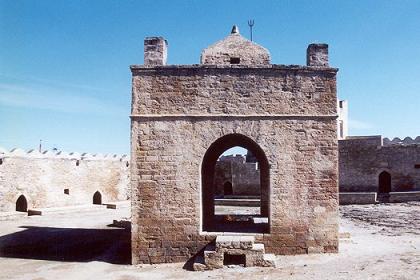
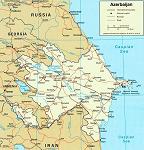
Jwalaji
or the goddess of fire in Azerbaijan
***
Baku (Azerbaijan): In an old settlement of oil
workers situated 30 km from this Azerbaijani capital is a rare
Hindu temple dedicated to 'Jwalaji
or the goddess of fire', forgotten for decades but now
catching the attention of tourists.
The
temple, called the `Atishgah,
in this predominantly Muslim republic of the former Soviet Union
is a typical Hindu shrine with an iron 'trishul'
on its roof with a dome.
Encircled
by a stone wall, the Jwalaji temple stands in the middle of a
courtyard, surrounded by cells for pilgrims coming all the way
from India to worship the Fire Goddess in its hey day.
Built
in 1713, a stone plaque in Hindi on the portal of the main gate
says that this gate was built by Ram Datt in 1866.
On
the carved entrances of cells are stone plaques describing who
built them and in which year. In all there are over 20 stone
plaques, of which 18 are in Devanagri, one in Gurumukhi and one
in Farsi (Persian), Sanskrit text on which begins in Hindu
tradition with "Om Shri Ganeshaye
Namah."
The
temple was built on the spot where subterranean gas leaking out
of the rocky ground used to burn day-and-night. Local records
say that it was built by a prominent Hindu traders community
living in Baku and its construction coincided with the fall of
the dynasty of Shirwanshahs and annexation by Russian Empire
following Russo-Iranian war.
(source:
Rare
Hindu Temple in Muslim Azerbaijan - sify.com). For
more refer to chapter on Greater
India: Suvarnabhumi and
Sacred
Angkor
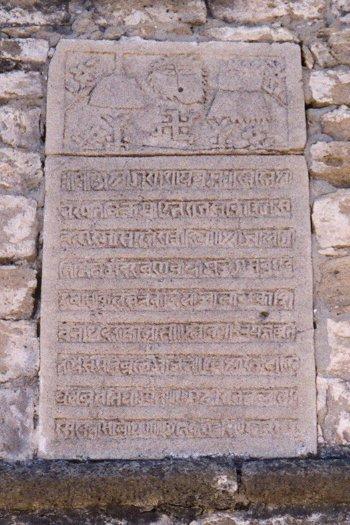
The ancient
Sanskrit and Hindi inscriptions.
***
Among the most interesting things
to see at the temple are the ancient Sanskrit and Hindi
inscriptions and the onion dome - signs that Atashgah and its
fire worship were heavily influenced by India. Flames burn at
each corner of the roof, fed by natural gas deposits under the
ground. The temple, which is part of a larger complex of
religious buildings, is located in the village of Surakhany,
20km (12mi) north-east of Baku.
(source: http://www.lonelyplanet.com/destinations/europe/azerbaijan/attractions.htm
http://www.ecosecretariat.org/Tourism/Azerbaijan/Azerbaijan.htm
http://www.intercaspian.com/photobank/az/pb_baku4.html).
Top
of Page
Vedic
Math: Crunch more in less time! By
Shraddha
Kamdar
Thousand-year-old 'sutras' can put the modern
math methods to shame.
Scientific
techniques developed thousands of years ago, mentioned in the
Vedas, are now being utilised by America's National Aeronautic
& Space Administration (NASA) and form a part of the
curriculum in European schools.
 Sadly,
however, they have lost importance in the country of origin.
Vedic Math, as it is called, is extracted from 16 'sutras' and
13 sub-'sutras' of the Vedas.
It is a set of techniques, which can be applied to a wide
spectrum of mathematic topics, to reduce the calculation time to
one-tenth of the actual time of any traditional method. Sadly,
however, they have lost importance in the country of origin.
Vedic Math, as it is called, is extracted from 16 'sutras' and
13 sub-'sutras' of the Vedas.
It is a set of techniques, which can be applied to a wide
spectrum of mathematic topics, to reduce the calculation time to
one-tenth of the actual time of any traditional method.
Professor Atul Gupta, an IIT engineer who chanced upon a book on
Vedic Math about a decade ago, was intrigued by it and learnt
from it. The process was long, but nonetheless interesting and
fruitful. Later, he thought of sharing his knowledge. Prof Gupta
now has school students, IIT aspirants, housewives and retired
persons who are simply math enthusiasts learning from him.
"It is so fascinating, it has turned math-haters into
math-lovers," claimed the professor.
Useful for Arithmetic, Algebra, Calculus, Trigonometry and
Astromomy, the techniques are easy to learn and remember. The
professor had this reporter so awe-struck with the methods, that
it was difficult to wind up the interview and move out of his
class. And he had not even touched the tip of the ice-berg.
"Now you can imagine what a treasure this is. It should be
passed on to our future generations," said Prof. Gupta. In
that regard, he has already conducted several workshops with
school children.
"These techniques are very helpful for IIT aspirants, as
the entrance exam papers are full of such questions. If they
save even about 10 minutes over all, imagine how many more
questions they'd be able to attempt!" said Prof. Gupta for
whom clearly Vedic Math is not just something he teaches, but is
also a passion. (For more details, contact 2551-3728,
2557-7553).
How
long does it take to divide 257910 by 9?
Using
a Vedic Math technique, the answer can be arrived at in a couple
of seconds! How?
It's simple.
Add all the digits of the number 257910 and reduce it to a
single digit: 2+5+7+9+1+0=24. Reduce 24 further -- 2+4=6, which
is the remainder.
Another way is by removing the digit 9 while adding. Or even the
digits that add up to 9. For example, in 257910 don't use 9, 2
and 7. By adding the remaining digits, you still get the correct
answer, i.e. 5+1+0=6.
This technique, called 'Navashesh',
is applicable to any number, but only while dividing it by 9. It
has a wide range of applications, to check humongous
multiplications and additions.
Another technique is finding the square of a number ending in 5.
For example, for squaring 85, all you have to do is take the
square of 5, i.e. 25, at the end, and multiply 8 by the next
arithmetic digit, 9 (8x9=72) and the answer is 7225.
(source: Vedic
Math: Crunch more in less time!
-
By
Shraddha
Kamdar - cybernoon.com).
For more refer to chapter on Hindu
Culture1 and Vedic
Math websites).
Top
of Page
Shivaji
- The Great Maratha Warrior
For about
three hundred and fifty years before Shivaji, Maharashtra was
not a free state. A large portion of it was under the rule of
the Nizamshah of Ahmednagar and the Adilshah of Bijapur. These
two had divided Maharashtra among themselves. Their officers
rules Maharashtra on their behalf. Adilshah and Nizamshah, were
very narrow in their outlook and oppressed the people over whom
they ruled. They were also sworn enemies of each other. They
constantly fought each other and as a result the people of
Maharashtra suffered untold hardships.
There
was hunger everywhere and the people were starving. People were
not free to celebrate festivals and worship their Gods openly.
Life was not safe at all and injustice prevailed everywhere.
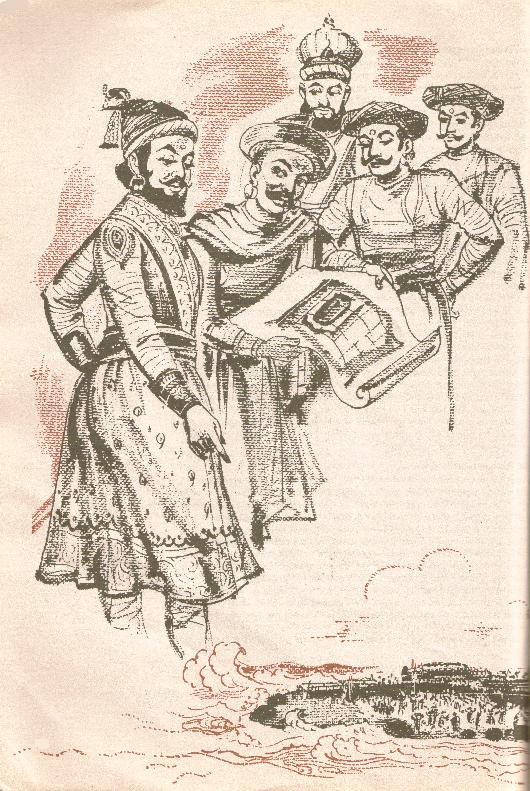
18 year old Shivaji and his faithfuls took the
oath at Rohedeshwar Temple to establish a nation of the natives
which Shivaji maintained was the will of the providence.
In his
next 35 years he lived an epic which thrilled the imagination of
his friends and foes alike.
Refer to chapter on Islamic
Onslaught
***
On
this background, 18 year old Shivaji and his faithfuls took the
oath at Rohedeshwar Temple to establish a nation of the natives
which Shivaji maintained was the will of the providence. In his
next 35 years he lived an epic which thrilled the imagination of
his friends and foes alike.
It
is true that Shivaji contributed a lot
towards the rise and growth of Maratha power in India,
but it is equally true that at the time he appeared on the
scene, the ground had already been prepared for him.
According
to Dr. Ishwari Prasad, "But Shivaji's rise to power cannot be treated as an isolated phenomenon
in Maratha history. It was as much the result of his personal
daring and heroism as of the peculiar geographical situation of
the Deccan country and unifying religious influences that were
animating the people with new hopes and aspirations in the 15th
and 16th centuries."

The Maratha the most formidable enemy; for he will not fail in
boldness and enterprise when they are indispensible, and will
always support them or supply their place, by stratagem,
activity and perseverance.
***
Pandit
Jawaharlal Nehru
said:
"Shivaji did not belong to Maharashtra alone; he belonged
to the whole Indian nation."
"Shivaji
was not an ambitious ruler anxious to establish a kingdom for
himself but a patriot inspired by a vision and political ideas
derived from the teachings of the ancient philosophers. He
studied the merits and faults of the systems of administration
in kingdoms existing at the time and determined his own policies
and administration in the light of that knowledge.
A
devout Hindu, he was tolerant of other religions and established
a number of endowments for maintainig sacred places belonging to
them. As a general he was undoubtedly one of the greatest in
Indian history; he saw the need for and raised a navy to guard
his coastline and to fight against the British and the Dutch.
Pratapgad Fort build in 1656 stands today as a monument to his
military genius. Shivaji
is a symbol of many virtues, more especially of love of
country."
A.B.
de Braganca Pereira Arquivo
Portugues Oriental, Vol III
wrote:
"Wonderous mystic, adventurous and intrepid, fortunate,
roving prince, with lovely and magnetic eyes, pleasing
countenance, winsome and polite, magnanimous to fallen foe like
Alexander, keen and a sharp intellect, quick in decision,
ambitious conqueror like Julius Caesar, given to action,
resolute and strict disciplinarian, expert strategist,
far-sighted and constructive statesman, brilliant organizer, who
sagaciously countered his political rivals and antagonists like
the Mughals, Turks of Bijapur, the Portuguese, the English, the
Dutch, and the French. Undaunted by the mighty Moghuls, then the
greatest power in Asia. He fought with Bijapuri to carve out a
great empire."
D.
Kincaid - The
Grand Rebel
"In
spite of the character of a crusade which Ramdas's blessings
gave to Shivaji's long struggle, it is remarkable how little
religious animosity or intolerance Shivaji displayed. His
kindness to Catholic priests is an agreeable contrast to the
proscriptions of the Hindu priesthood in the Indian and Maratha
territories of the Portuguese. Even his enemies remarked on his
extreme respect for Mussulman priests, for mosques and for the
koran. The Muslim historian Khafi Khan, who cannot mention
Shivaji in his cronicle without adding epithets of vulgar abuse,
nevertheless acknowledges that Shivaji never entered a conquered
town without taking measures to safeguard the mosques from
damage. Whenever a koran came to his possession, he treated it
with the same respect as if it had been one of the sacred works
of his own faith. Whenever his men captured Mussulman ladies,
they were brought to Shivaji, who looked after them as if they
were his wards till he could return them to their
relations."
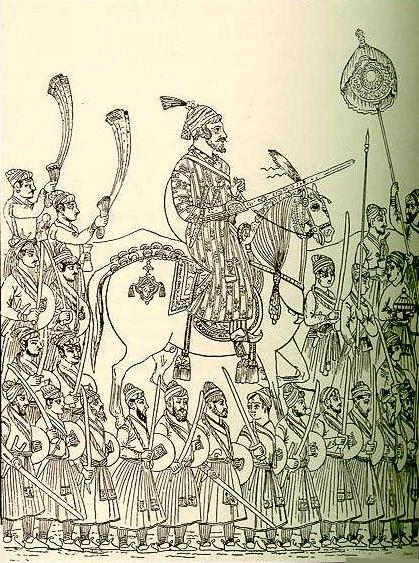
Shivaji:
The founder of the Maratha power.
(image source: India Armour - By
Lord Egerton, Lord of Tatton).
***
Cosme
da Guarda -
Life
of the Celebrated Sevaji:
"Such
was the good treatment Shivaji accorded to people and such was
the honesty with which he observed the capitulations that none
looked upon him without a feeling of love and confidence. By his
people he was exceedingly loved. Both in matters of reward and
punishment he was so impartial that while he lived he made no
exception for any person; no merit was left unrewarded, no
offence went unpunished; and this he did with so much care and
attention that he specially charged his governors to inform him
in writing of the conduct of his soldiers, mentioning in
particular those who had distinguished themselves, and he would
at once order their promotion, either in rank or in pay,
according to their merit. He was naturally loved by all men of
valor and good conduct."
Prime
Minister Indira
Gandhi
observed:
"I
think Shivaji ranks among the greatest men of the world. Since
we were a slave country, our great men have been somewhat played
down in world history. Had the same person been born in a
European country, he would have been praised to the skies and
known everywhere. It would have been said that he had illumined
the world."
Sir E. Sullivan says in Warriors
and Statesmen of India
"Shivaji possessed every quality requisite for success
in the disturbed age in which he lived.
Cautious and wily in council, he was fierce and daring in
action; he possessed an endurance that made him remarkable even
amongst his hardy subjects, and an energy and decision that
would in any age have raised him to distinctions.
By his own people he was painted on a white horse going
at full gallop, tossing grains of rice into his mouth, to
signify that his speed did not allow him to stop to eat.
He was the Hindu prince who
forced the heavy Mughal cavalry to fly before the charge of the
native horse of India. His strength and activity in action were glory and admiration of
his race."

O King Shivaji,
Lighting thy brow, like a lightning flash,
This thought descended,
"Into one virtuous rule, this divided broken distracted
India,
I shall bind."
***
Nobel laureate Rabindranath Tagore
wrote a poem:
In what far-off country, upon what obscure day
know not now,Seated in the gloom of some Mahratta
mountain-wood
O King Shivaji,
Lighting thy brow, like a lightning flash,
This thought descended,
"Into one virtuous rule, this divided broken distracted
India,
I shall bind."
As Sir
Jadunath Sarkar (1870-1958) eminent historian, has
well expressed:
 "Shivaji
proved, by his example, that the Hindu
race could build a nation, found a State, defeat its
enemies; they could conduct their own defence; they could
protect and promote literature and art, commerce and industry;
they could maintain navies and ocean going fleets of their own,
and conduct naval battles on equal terms with foreigners. He
taught the modern Hindus to rise to the full stature of their
growth. He demonstrated that the tree
of Hinduism was not dead, and that it could put forth
new leaves and branches and once again rise up its head to the
skies." "Shivaji
proved, by his example, that the Hindu
race could build a nation, found a State, defeat its
enemies; they could conduct their own defence; they could
protect and promote literature and art, commerce and industry;
they could maintain navies and ocean going fleets of their own,
and conduct naval battles on equal terms with foreigners. He
taught the modern Hindus to rise to the full stature of their
growth. He demonstrated that the tree
of Hinduism was not dead, and that it could put forth
new leaves and branches and once again rise up its head to the
skies."
(source:
Shivaji
and His Times - By Sir Jadunath Sarkar p. 406).
D.
F. Karaka author
of Shivaji:
Portrait of an Early Indian has written the following
passage:
"
...by birth a Hindu, by caste a Maratha but by his own
inclination Shivaji was an early Indian who fought to preserve
the native heritage of the people of the land from the foreign
invaders, at that time Moghul and Muslim, but to Shivaji's way
of thinking, it could
have been anyone else"
(source:
Shivaji:
Portrait of an Early Indian
- By Dosabhai Framji Karaka
p. 167).
Leaders
such as Lala Lajpat Rai, Tilak, Annie Besant, Aurobindo Ghosh
and poet Tagore have paid eloquent tributes to Shivaji as a
great national leader and the builder of the country.
(source:
Shivshahi.on
the Web). For more
refer to chapter on Islamic
Onslaught). Refer to chapter on Seafaring
in Ancient India for images of Maratha ships
called Mahartha Grab
and Gallivat ships attacking an English ship.
Top
of Page
The
Great Maratha Power
J. Grant Duff says in History
of the Marathas that:
"Bred a soldier as well as a statesman, Bajeerao united
the enterprise, vogour, and hardihood of a Maratha chief with
the polished manners, the sagacity, and address which frequently
distinguish the Brahmins of the Concan.
Fully acquainted with the financial schemes of his
father, he selected that part of the plan calculated to direct
the predatory hordes of Maharashtra in a common effort.
In this respect, the genious of Bajeerao enlarged the
schemes which his father devised; and unlike most Brahmins of
him, it may be truly said- he had both- the head to plan and the
hand to execute."
Sir R. Temple says in Oriental
Experiences
"Bajirao was hardly to be surpassed as a rider and was
ever forward in action, eager to expose himself under fire if
the affair was arduous. He
was inured to fatigue and prided himself on enduring the same
hardships as his soldiers and sharing their scanty fare.
He was moved by an ardour for success in national
undertakings by a patriotic confidence in the Hindu cause as
against its old enemies, the Muhammadans and its new rivals, the
Europeans then rising above the political horizon.
He lived to see the Maratha spread over the Indian
continent from the Arabian sea to the Bay of Bengal.
He died as he lived in camp under canvas among his men
and he is remembered among the Marathas as the fighting Peshwa, as the incarnation of Hindu energy."
Jadunath Sarkar says in
his forward to Peshwa Bajirao I and
Maratha Expansion
"Bajirao was a heaven born cavalry leader.
In the long and distinguished galaxy of Peshwas, Bajirao
Ballal was unequalled for the daring and originality of his
genius and the volume and value of his achievements. He was truely a carlylean Hero as king or rather as a Man of action.'
If Sir Robert Walpole created the unchallengeable
position of the Prime Minister in the unwritten constitution of
England, Bajirao created the same institution in the Maratha Raj
at exactly the same time."


The great
Maratha power - Bajirao Peshwa and Rani Lakshmi Bai.
***
Surendra Nath Sen says in
The Military System of the Marathas
"The lover of Mastani knew well how to appeal to the
religious sentiments of his co-religionists, although he could
scarcely be considered an orthodox Brahman... Shivaji had given
the Marathas a common cry, and none appreciated the potency of
that cry clearly than Peshwa Bajirao. Shivaji's
military reforms he would not or could not revive, but he stood
forth, as Shivaji had done, as champion of Hinduism.
People of Central and Northern India saw in him a new
deliverer."
According
to J.N. Sarkar, nature
developed in the Marathas "Self-reliance, courage, perseverance, a stern simplicity, a rough
straight-forwardness, a sense of social equality and
consequently pride in the dignity of man as man. "
There were no social distinctions among the people and Maratha
women added to the strength and patriotism of men.
According
to Elphinstone
"They (the Marathas) are all active, laborious, hardy and
persevering. If they have none of the pride and dignity of the
Rajputs, they have none of their indolence or want of worldly
wisdom. A Rajput warrior as long as he does not dishonour his
race, seems almost indifferent to the result of any contest he
is engaged in. A Maratha thinks of nothing but the result, and
cares little for the means, if he can attain his object. For
this purpose, he will strain his wits, renounce his pleasures
and hazard his person; but has not a conception of sacrificing
his life, or even his interest for a point of honour. This
difference of sentiment affects the outward appearance of the
two nations; there is something noble in the carriage of the
ordinary Rajput, and something vulgar in that of the most
distinguished Maratha. The Rajput is the most worthy antagonist
- the Maratha the most formidable
enemy; for he will not fail in boldness and
enterprise when they are indispensible, and will always support
them or supply their place, by stratagem, activity and
perseverance. All this applies chiefly to the soldiery to whom
more bad qualities might fairly be ascribed. The mere husbandmen
are sober, frugal and industrious, and though they have a dash
of national cunning, are neither turbulent nor insincere."
Warren
Hastings had noted, "..The Marathas possess
alone of all the people of Hindostan and the Deccan a principle
of national attachment, which is strongly impressed on all the
individuals of the nation.."
Sir
Hugh Rose the commander of the British force, wrote
later, "The Ranee was remarkable for her bravery,
cleverness and perseverance; her generosity to her Subordinates
was unbounded. These qualities, combined with her rank, rendered
her the most dangerous of all the rebel leaders." A popular
Indian ballad said:
How
valiantly like a man fought she,
The Rani of Jhansi
On every parapet a gun she set
Raining fire of hell,
How well like a man fought the Rani of Jhansi
How valiantly and well!
"Bundeli har boli mein suni
yehi kahani thi...
Khoob laDi mardaani woh toh Jhansi Wali Rani thi...."
(source:
Hindunet.org).
For more on Rani Lakshmi Bai refer to chapter on Women
in Hinduism and European
Imperialism). For
more refer to chapter on Greater
India: Suvarnabhumi and
Sacred
Angkor
Top
of Page
Lord Ganesha -
Vinayaka in unique form - By V Ganapathy
The
Nandrudayan Vinayaga temple in Devadhanam, Tiruchi, boasts of
the unique Adi Vinayagar granite idol
depicting Lord Ganesha with his original divine face without the
usual elephantine head and the trunk.
The
five-foot tall majestic presiding deity of the temple -
Nandrudayan Vinayagar adorning a Naghabharanam around his waist,
has a Naganandhi facing him at the Eastern entrance of the
temple. It may be mentioned that Nandi Deva is generally
associated with Siva Temples only. The Seventh Century Tamil
savant Sambandar had in one of his pathikams praised the
presiding deity of the temple thereby indicating that this is
one of the oldest temples in Sirapalli (Tiruchi).
The
four-foot tall Adi Vinayagar is installed in a separate shrine
close to the sanctum sanctorum and the divine grace of
the brilliantly sculptured granite idol is indeed captivating.
In the one hand Lord Ganesha holds the
axe, symbolising the destruction of all desires, a
rope to indicate his willingness to rescue anyone from the mire
of vasanas, the modaka representing the joyous reward of
spiritual life, and lotus symbolising that all can achieve the
supreme state of self-realisation. The large belly of Ganesha is
to convey the idea that a Man of Perfection can consume and
digest whatever experience he undergoes. The tiny rat which is
seated in front of the Lord amidst a rich collection of food is
to indicate that a perfect man - like the rat, will have total
control over his desires.

A
unique Adi Vinayagar granite idol depicting Lord Ganesha with
his original divine face without the usual elephantine head and
the trunk.
***
Inside
the small shrine one could also see the idols of Adi Sankara,
Sage Veda Vyasa, Goddess Gayatri, Sadasiva Brahmendra and Saint
Pattinathar. According to Sage Ramarathinam, Trustee of the
temple, the Kanchi Paramacharya, used to offer worship at the
Thayumanavar and Uchipillayar temples atop the Rockfort. When he
visited the temple about 60 years ago he suggested the rendering
of the Vedas in the temple everyday it is being followed, the
reciting done by scholars. Just behind the sanctum sanctorum an
Anjaneya shrine has been established and the temple has separate
shrines for Lord Muruga, the Navagrahas, Goddess Durga and Lord
Ayyappa in the other Mandapam. Special poojas are performed for
Adi Vinayagar on Thursdays. In the annual music festival
conducted for the past 83 years almost all leading musicians
have participated. It may be recalled that Devadhanam of today
is highly congested where daily wage earners, rag pickers,
dealers in old second hand household articles, etc. live. A
couple of centuries ago, prior to the establishment of the Town
railway station Devadhanam was the entry point to the city from
the East. Situated very close to the Cauvery, Devadhanam sported
some very important and ancient temples, the Bhoologanathaswami
temple, Veerasoora Mahakaliamman temple, Nandrudayan temple,
etc. There were four huge tanks close to these temples all of
which have now been converted into lorry stand, weekly market
and parks. In recent years the residents of the area have taken
a keen interest in preserving old and ancient temples.
(source: Vinayaka
in unique form - By V Ganapathy -
hindu.com). For more refer to chapter on Symbolism
in Hinduism).
Top
of Page
Cosmic
Balance and World Peace
-
By
Frederic
Lamond
Until
3,000 years ago, all religions were pantheistic and polytheistic
as Hinduism, Taoism and Shinto still are. They tolerated the
religions of other tribes and cultures, recognizing in their
worship the same divine energies as their own, albeit with
different names.
Why
then did patriarchal, monotheistic religions arise in the Middle
East 3,000 years ago, and spread in their Christian forms
throughout Europe and then on to the European colonized overseas
territories during the last 1,500 years? Why did these
monotheistic religions fight so fiercely to eradicate
nature worship in the lands they controlled? Why did
Christianity promote a dualistic antagonism between the spirit
and the flesh, with only the former conceived as being in the
‘‘image of God’’?
(source:
Cosmic
Balance and World Peace
- By Frederic
Lamond).
For more refer to chapter on Nature
Worship).
"All
religions have a home in the vast cauldron of spirituality that
is India."
Top
of Page
Ramjanmabhoomi
- Evidence from Ayodhya

A 12th century
plaque showing gandharvas holding garlands
Watch History
of Ayodhya - videogoogle.com.
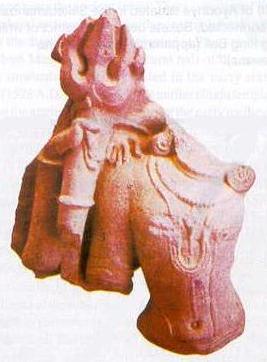
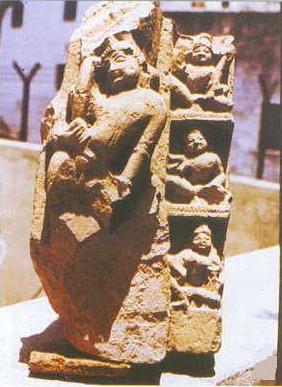
Fractured
Shiva-Parvati statue, the trishul style points to 11-12th
century. - Figurine of a goddess.
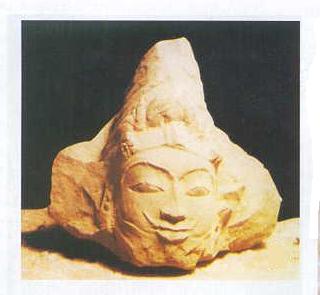
A 12th century
Bhairava murthy with matted locks, large eyes and protruding
teeth.
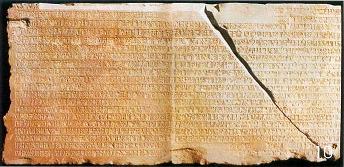
A 12th century inscription
recovered from the site on 6 December 1992, considered as a
'clinching evidence' by many senior archaeologists and
historians. The illustrious
Gahadavalas dynasty, is credited with the construction of the
Ram temple found below the Babri structure at Ayodhya

"The inscription is
composed in high-flown Sanskrit verse, except for a very small
portion in prose, and is engraved in the chaste and classical
Nagari script of the 11-12th century A.D. It was evidently put
up on the wall of the temple, the construction of which is
recorded in the text inscribed on it. Line 15 of this
inscription, for example clearly tells us that a beautiful
temple of Vishnu-Hari, built with heaps of stone (silasamhati-grahais),
and beautified with a golden spire (hiranya-kalasa-srisundaram)
unparalleled by any other temple built by earlier kings (purvvairapy-akritam
kritam nripatibhir) was constructed. This wonderful temple (aty-adbhutani)
was built in the temple-city of Ayodhya situated in the
Saketamandala showing that Ayodhya and Saketa were closely
connected, Saketa being the district of which Ayodhya was a
part. Line 19 describes God Vishnu as destroying king Bali
(apparently in the Vamana manifestation) and the ten headed
personage (Dasanana, i.e. Ravana).
(Translation of the above
inscription provided by Prof. Ajaya Mitra Shastri, former
Chairman, Epigraphical Society of India, Nagpur. India).
Watch History
of Ayodhya - videogoogle.com.
(source: Ramjanmabhoomi:
Facts and Figures - Hindu
Renaissance periodical - Gurupaurnima, Ravivar,
Ashadh Shudhha 15, Yugabda 5105 p. 32 - 33). For more
refer to chapter on GlimpsesVII).
***
Sir V S Naipaul on the Islamic Onslaught
"I
would call it (the destruction of the Babri Masjid) an act of
historical balancing. The mosque built by Babar in Ayodhya was
meant as an act of contempt. Babar was no lover of India. I
think it is universally accepted that Babar despised India, the
Indian people and their faith."
""Fractured past" is too polite a way to describe
India's calamitous millennium. The millennium began with the
Muslim invasions and the grinding down of the Hindu-Buddhist
culture of the north. This is such a big and bad event that
people still have to find polite, destiny-defying ways of
speaking about it. In
art books and history books, people write of the Muslims "arriving"in
India, as though the Muslims came on a tourist bus and went away
again. The
Muslim view of their conquest of India is a truer one. They
speak of the triumph of the faith, the destruction of idols and
temples, the loot, the carting away of the local people as
slaves, so cheap and numerous that they were being sold for a
few rupees. The
architectural evidence-the absence of Hindu monuments in the
north-is convincing enough. This conquest was unlike any other
that had gone before.
There
are no Hindu records of this period. Defeated people never write
their history. The victors write the history. The victors were
Muslims. For people on the other side it is a period of
darkness. Indian history is written about as a matter of rulers
and kingdoms shifting and changing. This is why it all seems
petty and boring to read and hard to remember. But
there is a larger and more tragic and more illuminating theme.
That theme is the grinding down of Hindu India.
(source:
OutlookIndia.com,
15 November 1999
and http://www.indpride.com/vsnaipaul.html).
***
Rampant
Negationism : The Indian Marxists - By Koenraad Elst
One should know that there is a strange alliance between the
Indian communist parties and the Muslim fanatics. Marxism
dehumanizes people to impersonal pawns, or “forces” in the
hands of god History. The Marxist
historians had the field all to themselves, and they set to work
to “decommunalize” Indian history-writing, ie. To erase the
importance of Islam as a factor of conflict.
In Communalism and the Writing of
Indian History, Romila Thapar, Harbans Mukhia and
Bipin Chandra, professors at Jawaharlal Nehru University
(JNU, the Mecca of “secularism” and negationism) in Delhi,
write that the interpretation of medieval wars as religious
conflicts is in fact a back-projection of contemporary religious
conflict artificially created for political purposes. They
explicitly deny that before the modern period there existed such
a thing as Hindu identity or Muslim identity. Conflicts could
not have been between Hindus and Muslims, only between rulers or
classes who incidentally also belonged to one religious
community or the other. It is of course a fact that in the
Jewish ghetto in Warsaw the Nazis employed Jewish guards: this
does not disapprove Nazi-Jewish enemity. Time
and again, the negationist historians (including Bipan Chandra,
K N Panikkar, S. Gopal, Romila Thapar, Harnans Mukhia, Irfan
Habib, R S Sharma, Gyandra Pandey, Sushil Srivastava, Asghar Ali
Engineer, as well as the Muslim fundamentalist politician Syed
Shahabuddin) have asserted that the tradition according to which
the Babri mosque forcibly replaced a Hindu temple, is nothing
but a myth purposely created in the 19th century.
To explain the popularity of the myth even among local Muslim
writers in the 19th century, most of them say it was
a deliberate British concoction, spread in the interest of the
“divide and rule” policy. They affirm this conspiracy
scenario without anyhow citing, from
the copious archives which the British administration in India
has left behind, any kind of positive indication for
their convenient hypothesis – let alone the rigorous proof on
which a serious historian would base his assertions, especially
in such controversial questions.
Personal Attacks on Opponents
In December 1990, the leading JNU historians and several
allied scholars, followed by the herd
of secularist pen-pushers in the Indian press, have
tried to raise suspicions against the professional honesty of
Prof. B B Lal and Dr. S P Gupta, the archaeologists who have
unearthed evidence for the existence of a Hindu temple at the
Babri Masjid site. Rebuttals by these
two and a number of other archaeologists have received minimal
coverage in the secularist press.
I have been thinking of the behavior of our Marxist friends
and historians, their unprovoked slander campaign against many
collegues, hurling abuses and convicting anyone and everyone
even before the charges could be framed and proved. Their latest
target is so sober and highly respected a person as Prof. B B
Lal, who has all his life never involved himself in petty
politics or in the groupism so favorite a sport among the
so-called Marxist intellectuals of this country. But
then slander is a well-practised art among the Marxists.”
(source:
Negationism
in India - By Koenraad Elst p.
37 -41). Refer
to My
People, Uprooted: "A
Saga of the Hindus of Eastern Bengal"
- By Tathagata Roy
Watch History
of Ayodhya - videogoogle.com.
Top
of Page
Submerged city
may be older than Mesopotamia
There
is growing evidence that the East Coast of India was the real
cradle of modern civilization. Perhaps it's time to rewrite the
history books...?

The Big Temple
built by Rajaraja Cholan - This temple is a fine example for the
Indian sculptural architecture greatness. The temple tower
sanctum sanctorum is 216 feet tall.
***
A
submerged coastal city near
Poompuhar in Nagapattinam, Tamil
Nadu, is the focus of a major expedition being conducted jointly
by the Indian Naval Hydrographic Department (INHD) and the
Archaeological Survey of India (ASI).
Both
the organizations are trying to piece together the city's past,
which some noted marine archaeologists consider to be the
birthplace of modern civilization. The once flourishing port
city is located about one mile off the Nagapattinam coast.
"We
have been able to locate a section of the city at a depth of 7 m
and will soon start operations to recover objects that will help
ascertain its past," said Rear Admiral K.R. Srinivasan,
chief hydrographer to the Indian government. English
marine archaeologist Graham Hancock, who conducted an underwater
exploration in the area in 2001, believes that the Poompuhar
site could be older than Sumeria in Mesopotamia, where modern
civilization is believed to have originated nearly 5,000 years
ago.
It
led Hancock to surmise that the city could have been submerged
by a tidal wave as high as 400 ft somewhere between 17,000 and
7,000 years ago.
(source:
Submerged
city may be older than Mesopotamia - By Utpal
Parashar
- hindustantimes.com).
For a panoramic view of the Big
Temple). For more refer to chapter on Aryan
Invasion Theory).
For
more refer to chapter on Greater
India: Suvarnabhumi and
Sacred
Angkor
Top
of Page
Where's
India's holocaust museum? - By Francois Gautier
The
massacre of 6 million Jews by Hitler and the persecution Jews
suffered all over the world in the last 15 centuries has been
meticulously recorded by the Jews after 1945 and has been
enshrined not only in history books, but also in Holocaust
museums, the most famous one being in Washington, DC.
Hindus,
Sikhs and Buddhists have also suffered a terrible holocaust,
probably without parallel in human history. Take the Hindu Kush
for instance, probably one of the biggest genocides of Hindus.
There is practically no serious research ever done about it and
no mention in history books. Yet the name Hindu Kush appears
many times in the writings of Muslim chroniclers in 1333 AD. Ibn
Battutah, the medieval Berber traveller, said the name meant
'Hindu Killer,' a meaning still given by Afghan mountain
dwellers. Unlike the Jewish holocaust, the exact toll
of the Hindu genocide suggested by the name Hindu Kush is not
available. 'However,' writes Hindu Kush specialist Srinandan
Vyas, 'the number is easily likely to be in millions.'
Afghanistan
was a full part of the Hindu cradle up till the year 1000,
and in political unity with India until Nadir Shah separated it
in the 18th century. The mountain range in Eastern Afghanistan
where the native Hindus were slaughtered, is still called the Hindu
Kush.
(Note:
To
the Hindus, this mountain range was known as Paariyaatra
Parvat. But when
the last Hindu king of Kabul was killed. Muslims ruled
this land and then called these mountains the Hindu Kush --
"Slaughter of the Hindus" ).
It
is significant that one of the very few place-names on earth
that reminds us not of the victory of the winners but rather of
the slaughter of the losers, concerns a genocide of Hindus by
the Muslims.
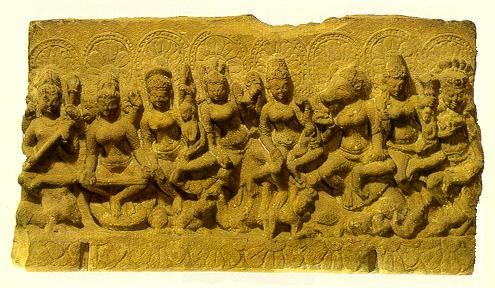
The saptamatrikas
A
few known historical figures can be used to justify this
estimate. The Encyclopaedia Britannica recalls
that in December 1398 AD, Taimurlane ordered the execution of at
least 50,000 captives before the battle for Delhi; likewise, the
number of captives butchered by Taimurlane's army was about
100,000.
The Britannica
again mentions that Mughal emperor
Akbar ordered the massacre of about 30,000 captured Rajput
Hindus on February 24, 1568 AD, after the battle for Chitod, a
number confirmed by Abul Fazl, Akbar's court historian.
Afghan historian Khondamir notes that
during one of the many repeated invasions on the city of Herat
in western Afghanistan, which used to be part of the Hindu
Shahiya kingdoms '1,500,000 residents perished.'
'Thus, 'it is evident that the mountain range was named as Hindu
Kush as a reminder to the future Hindu generations of the
slaughter and slavery of Hindus during the Moslem conquests.'
Kashmir
was also the crucible of knowledge, spirituality, a hallowed
centre of learning and the cradle of
Shivaism. It was known as Sharda
Peeth, the abode of learning. Kashmiri Pandits
excelled in philosophy, aesthetics, poetics, sculpture,
architecture, mathematics, astronomy and astrology. Sanskrit was
studied, propagated and spoken by women and men. Scholars
like Kalhan, Jonraj, Srivar, Abhinavgupta, Somanand, Utpaldev,
Somdev and Kshemendra created an intellectual centre of
unrivalled repute. Fundamentalism and terrorism have
been ruthless in their assault on Sharda Peeth, zealous in
ravaging its heritage, and consistent only in bloodthirsty
intolerance. The destruction of Hindu places of worship, forced
conversions of Pandits and death and ignominy to those who
resisted, were accompanied by a savage assault on literary
activity. This process has been going on since centuries.
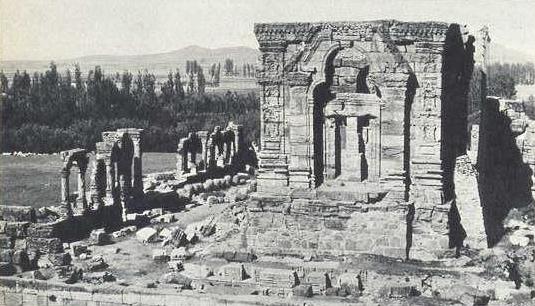
Sun
Temple: The most memorable and beautiful work of
Lalitaditya Mukhtapida is the construction of spacious Martand
temple which the emperor got built in honour of the Sungod -
Bhaskar. Martand has a very high place in the world's great
architecutral designs. The temple is a mirror of the art
and skill of Kashmiri Hindus. This way Lalitaditya should not be
considered a founder of a vast empire but also a founder of art
and skill of Kashmiri Hindus for six centuries.
Watch History
of Ayodhya - videogoogle.com.
***
In the Hindu imagination, Kashmir is
said to be the abode of gods. Amid these deeply forested hills,
Siva is said to have narrated to his consort Parvati, the sacred
Amarkatha, the secret of immortality. In ancient times,
Kashmir was known as Sarada Peeth, the seat of the goddess of
learning. In
Kashmir, visions of the lord's glory are constantly in front of
us. It is only natural that the unique form of Kashmir Saivism
developed here. In this philosophy there is a great emphasis on
the worship of Sakti, who is the manifestation in this world of
the ideal that is Siva. She is seen constantly in the beauty and
grandeur of the great mountains, in crystal-clear streams of
water and in the deep beauty of the still lakes of Kashmir. Indian
thinkers have always seen the world around as a reflection of
the beauty of God. It is believed that the feeling of ecstasy
upon seeing the beauty of nature or a truly fine work of art is
akin to brahmananda (the final bliss of enlightenment) itself.
In that moment of bliss, the faithful sense their oneness with
the whole of creation and the great beauty of God that is
reflected in every aspect of the world
***
We
would also like to start another exhibition
on forced Christian conversions in the Northeast. Ultimately,
we would like to build a Hindu/ Sikh/Buddhist Indian Holocaust
Museum based in New Delhi, or in Bangalore. It will record not
only the genocide of Hindus Sikhs and Buddhists at the hands of
Muslim invaders, but also the terrible persecution
of the Portuguese (hardly mentioned in Indian history
books) and British -- nobody
knows for instance that 20 million Indians died of famine
between 1815 and 1920, because the English broke the
agricultural backbone of India to get raw materials like cotton,
jute etc.
Hence,
with two journalist friends, we started a Foundation: FACT --
Foundation Against Continuing Terrorism.
We need your support for this Indian Holocaust Museum.
(source: Where's
India's holocaust museum? - By Francois Gautier -
rediff.com and Ayodhya
and After - By Koenraad Elst Voice of India SKU:
INBK2650 p.278).
http://www.flonnet.com/fl2109/stories/20040507000106500.htm.
For more on Martand Temple refer to Converted
Kashmir and http://ignca.nic.in/asp/showbig.asp?projid=rar1
and http://www.jktourism.org/cities/kashmir/site-see/shrines.htm#8.
For more refer to chapter on Islamic
Onslaught and European
Imperialism). Refer to
My
People, Uprooted: "A
Saga of the Hindus of Eastern Bengal"
- By Tathagata Roy
Top
of Page
Pray,
why this leap of faith?
Fraudulent use of Hindu Scriptures by Christian Evangelists?
For
long they have said Hindu Gods were devils and any worship of
Them is a heathen practice. Now Christian zealots have outdone
themselves by taking a giant leap of faith and claiming that the
various Vedic Sanskrit slogans were in praise of Jesus and not
Hindu Gods.
Christian
propaganda pamphlets and booklets in circulation especially in
and around Madurai district also make the ludicrous suggestion
that Swami Vivekananda had asked the people to worship Jesus.
The pamphlets, which have been put in circulation by the Madurai-based
Infant Jesus Hospital (headed by one Rev Fr. Caleb), also
fraudulently invoke Bhagawat Gita slogans saying that they
preach against idol worship. The highly inflammatory but dubious
pamphlets, which the footsoldiers (primarily women) of Christian
expansionism have been delivering at doorstep after doorstep in
Southern districts, go as far as to decree that 'people should
not follow any other faith other than Christianity'.
Just
sample some of the 'interpretations' in the pamphlets:
Om
Sri Brahma Puthraya Nama reads as 'I worship Jesus, who came to
the world as God's son (Yowan 3:16.17)'.
Om
Shri Dakshina Murthaya Nama is translated as 'I worship Jesus
who is sitting on the thigh of his father (Yowan (1:18)'.
Taking
specific mantras from Sama Veda,
the Christian marketers say 'Om Sri Panchakaya Nama refers to
Jesus, the one with five wounds (panchakaya) Yowan 20:25.27. Om
Sri Ummathiya Nama is translated as 'I hail one born to the holy
spirit' (Mathew 1:18).
Parajapathi
is taken to be representing the Christ and several quotes are
given to suggest that Hinduism had all along had been talking
about the 'Holy Saviour'.

A
Tamil advertisement posted by a Church claiming that Hinduism is
been derived from 'Thomasian' Dravida Christianity. The highly inflammatory but dubious
pamphlets, which the footsoldiers (primarily women) of Christian
expansionism have been delivering at doorstep after doorstep in
Southern districts, go as far as to decree that 'people should
not follow any other faith other than Christianity'.
Refer
to Religious
Freedom Report as a Political Weapon - According
to the report, there seems to be mainly one discriminated
minority in
India
: the Christian missionaries.
Refer
to
Persecution
complex - Evangelical lawmakers behind creation of USCIRF
***
The
pamphlets go the whole hog and reel out several texts from the
hoary Rig Veda, saying all
of them were meant for Christianity.
The
mantra from Brihat Aranyako
Upanishad (Asathoma sadhgamaya,
Tamasoma Jyothirgamaya...) is laboriously expanded and explained
to mean that Jesus is leading as the light of the world.
And the 'explanation' goes on to add: 'there is a word-to-word
answer in the bible to every prayer in the Upanishad'.
Bhagwat
Gita is also not left alone. In a seeming translation
of a verse from Neethicharam, the pamphlet says that 'those
fools who worship statues made up of stone, wood and metal would
beget nothing other than misery and would not be pardoned'.
Of
course, this is plain duplicitous misinterpretation. But they
have not stopped with that. They go on to plain falsehoods. The
pamphlets invoke Swami Vivekananda and say that he wanted
hundreds and thousands of Christian religious workers to come to
India so that the preaching of Jesus could go to the hearts of
all Hindu people.
Understandably
the locals are highly offended at the effrontery of the
evangelists. Apart from the farcical and facile reasonings in
the hand-outs, the locals say the fact they (evangelists) made
bold to deliver them in every household makes clear their rabid
fundamentalism. The brazen approach of the Christian
preachers is a major talking point in the Southern districts for
quite some time. They brook at no niceties. Anything goes for
them. The ways are unimportant to them. In
going about their patently communal ways, they have vitiated the
general atmosphere in the districts. The
prayers (real ones) of the peace-loving people to the
authorities have had no effect so far.
(source:
Pray,
why this leap of faith? - newstodaynet.com and The
Hijacking of Hinduism - Indians Against Christian Aggression).
Top
of Page
Who was this Staines really?
- By
Chitranjan Mahopadhyay
The
case is almost closed now. Dara Singh has been convicted, Graham
Staines is widely regarded as a martyr. The first one is seen as
a symbol of communal Hindu mind while the other as an innocent
do-gooder for the tribals. But is the
truth really so? Was Staines just a simple-minded
social worker working amongst the tribals of Orissa for leprosy
eradication and Dara Singh a rabid communalist?
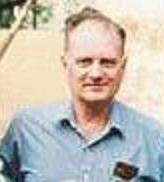 Nobody
denies that Staines was involved in leprosy treatment. But, as
many tribals in the area point out even today, Staines
was involved in something more sinister too: Converting to
Christianity innocent and gullible tribals who accepted him and
his family readily. Nobody
denies that Staines was involved in leprosy treatment. But, as
many tribals in the area point out even today, Staines
was involved in something more sinister too: Converting to
Christianity innocent and gullible tribals who accepted him and
his family readily.
It
is easy and almost facile to glorify Staines in the aftermath of
his gory death. There is no justification for his killing, yet
very importantly he was no saint out to merely help the tribals.
Right from 1965 when he came to this sleepy village Mayurbhanj,
Staines was just a simple missionary out to add numbers to his
religion. The leprosy eradication work was plain incidental.
This
is a fact that can be verified even today with the tribals.
Staines was the Secretary of the Evangelical Missionary Society
of Mayurbhanj (EMSM).
Locals
say that as a missionary, Staines was primarily preaching the
gospel and spreading the tenets of Christianity in jungle camps
held in different tribal belts in the district of Mayurbhanj and
Keonjhar. Many such camps were held
very close Hindu festivals. Tribals say that during such camps
the talk and focus would be around belittling Hindu festivals
and Gods. This led to tension and unease in the
locality.
But
Staines seemed prepared for confrontations, and whenever some
angry tribals accosted and took him on the subject, he would not
retaliate in angry words. His reaction was a practised silence.
It is easy and almost natural to interpret this as example of
his essential simple and peace-loving attitude. But the actual
truth was Staines was striking two mangoes with one stone:
Getting the tribals converted even while stoking the anger of
others to show them as the villains of the situation.
Machiavelli could not have bettered this. It is a classical
ploy, and it worked it works even today.
Staines
efforts at conversion paid rich dividends as he managed to get
the entire Ho and Santal tribes to Christianity. The
tribals converted to Christianity distanced themselves from the
non-Christian tribals and adopted anti-tribal customary practice
of eating beef and ploughing land during Raja festival (when
according to the tribal custom the land was to be kept fallow).
In
a show of brinkmanship, they also played Christian audio
cassettes in marriage functions to the chagrin of tribals.
As
because of this, tension and unease was a constant in the
locality. Innocent tribals who had
lived together in peace and harmony for long were now ranged up
against each other.
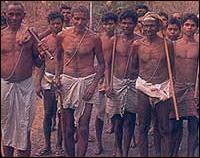

Innocent tribals who had
lived together in peace and harmony for long were now ranged up
against each other.
Refer
to Religious
Freedom Report as a Political Weapon - According
to the report, there seems to be mainly one discriminated
minority in
India
: the Christian missionaries.
Refer
to
Persecution
complex - Evangelical lawmakers behind creation of USCIRF
***
It is in such a scheme of things
that an angry young man from Auriya in Uttar Pradesh named
Rabindra Kumar Pal alias Dara Singh came to the area. He was
young and volatile, and hence could not stand what was happening
around. But his mental make up was such that he was not ready
for the nuanced psychological warfare that his adversaries were
waging. Like his words, Dara Singh's action were also blunt.
Some of the non-Christian tribals of Manoharpur and nearby
villages seething at the behaviour of tribal converts in
shunning tribal traditions found a Messiah (if that is the word)
in Dara Singh.
Soon
enough, the inevitable happened. Staines and his sons were set
ablaze. It was a heinous crime no doubt, but in a sense it
was waiting to happen. Staines was
courting disaster with his extremely provocative actions. Perhaps
that was the plan, after all. After such a high-profile event
which the media also jumped on to, there was nobody to really
understand what had really happened. Worse,
there none to ask the question 'why'. The case that the
media built was: 'Dara Singh was so communal that he could not
tolerate the good work of the Christian Staines'. The
truth alas, as the locals say even today, was totally different.
Like many things in Indian
history, the story of Staines is also being written with an ink
dipped in falsehoods and sweeping generalisations.
(source:
Who was this Staines really?
- By Chitranjan Mahopadhyay ).
For more on Staines refer to chapter on Conversion
and www.hvk.org/specialrepo/wadhwa/Graham.html).
Sign
the petition - UN
& Religious Proselytization
- petitiononline.com).
Besides his Involvement with
Leprosy Home, Staines was also involved
in missionary work. The missionary work of
Staines has come to light from the various despatches sent by
him to Australia, which is published in a newsletter
'Tidings'. The fact
that Staines was murdered for his “aggresive evangelism”
should be a sign that things are not hunky-dory for
religion-based missionaries in India. Why do missionaries have
to try and weave religion into their humanitarian efforts? Is it
not enough to care and look after the needy wiothout expecting
them to change their religion as the “price” for their
welfare?
Supreme
Court of India bans Conversions
A Supreme Court judgment
in 1977 had clearly declared conversion as an unconstitutional
activity holding that the right to propagate religion didn't
constitute the right to convert people of one religion to
another.
(source: Supreme
Court of India bans Conversions
- timesofindia.com). For more refer to The
Sunshine of Secularism).
For more refer to The
War against Hinduism - By Stephen Knapp
and Indians
Against Christian Aggression.
Sign
the petition - UN
& Religious Proselytization
- petitiononline.com).
Refer
to VINDICATED BY TIME: The Niyogi Committee Report On
Christian Missionary Activities -
Christianity
Missionary Activities Enquiry Committee 1956
and
The
Sunshine of Secularism.
Top
of Page
Conversion
confusion - By B S Ragahavan
The
fury of the Church leaders
all over the country directed at the Tamil
Nadu ordinance against religious conversions by allurement,
inducement, or coercion is not in consonance with the
sobriety and restraint usually associated with members of that
faith. Some Archbishops have issued threats of closing
educational institutions run by them.
The
outcry engineered by Christian community leaders, with Muslim
support, is exactly similar to the one
following the law of erstwhile Travancore State on temple entry.
At that time, the Archbishop of Canterbury lambasted it as a
deliberate roadblock set up against conversions of the
untouchables to the Church.
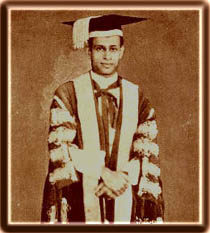
Sree
Chithira Thirunal Maharaja of Travancore - Kerala made the
historical Temple Entry Proclamation, opening the temples of
Travancore for all Hindus irrespective of caste.
Refer
to VINDICATED BY TIME: The Niyogi Committee Report On
Christian Missionary Activities -
Christianity
Missionary Activities Enquiry Committee 1956
***
(Note:
In
1936, Sree Chithira Thirunal
Maharaja of Travancore made the
historical Temple Entry
Proclamation, opening the
temples of Travancore for all Hindus irrespective of caste).
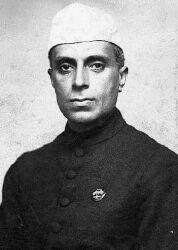 Likewise,
when during a debate on the activities of Christian missionaries
in 1954, the Home Minister, Kailash
Nath Katju, made it clear that missionaries coming to
India only for evangelical work had better stay home, there was
a synthetic furore from the Church leaders. Pandit
Jawaharlal Nehru
(than whom it is hard to imagine a more fervent secularist)
asked Maulana Abul Kalam Azad to tell
off Archbishop Valerian Cardinal Gracias that that while
conversion by an individual out of deep conviction was
unexceptionable, there was no room for mass conversions of the
kind indulged in by missionaries by inducement and alienation
and that Katju had only expressed a `sensible view''. Likewise,
when during a debate on the activities of Christian missionaries
in 1954, the Home Minister, Kailash
Nath Katju, made it clear that missionaries coming to
India only for evangelical work had better stay home, there was
a synthetic furore from the Church leaders. Pandit
Jawaharlal Nehru
(than whom it is hard to imagine a more fervent secularist)
asked Maulana Abul Kalam Azad to tell
off Archbishop Valerian Cardinal Gracias that that while
conversion by an individual out of deep conviction was
unexceptionable, there was no room for mass conversions of the
kind indulged in by missionaries by inducement and alienation
and that Katju had only expressed a `sensible view''.
Protestantism,
Catholicism, Islam, Buddhism, Marxism, Socialism, Capitalism,
are all linear, proselytising systems, constantly looking for
ways to cut into each other's space. There has always been a
fundamental difficulty when these linear, proselytising systems
come into contact with a circular system, one that does not
proselytise.
A
letter written by Maulana
Azad, as education minister, to Cardinal
Gracias.
"But
there is another method of conversion: of social reasons or for
a common cause, a large group of people makes up its mind to
defect from one religion to another. If each individual of this
group were asked to explain why he left the faith of his
forebears, I am certain he will not be able to advance a reason
persuasive enough that such a person has actually reflected on
the question of religion and truth. On most occasions such
groups are composed of people who have no education, people who
are singularly incapable of making up their minds on issues that
inform a matter as serious a religious belief.
"Similarly, conversion of young children, who have not
developed a sense of right and wrong, cannot be considered as
true religious conversion."
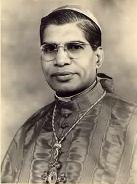 Persons
in public life who have no political or religious axe to grind
have been pointing out that the ordinance is not born out of a
sudden machination by Ms Jayalalithaa, that similar laws have
been in existence for 30 years or more in Arunachal Pradesh,
Mahya Pradesh and Orissa and that, when the Madhya Pradesh law
was challenged before the Supreme Court on a variety of
plausible and far-fetched grounds, it unambiguously upheld in
memorable words its Constitutional sanction, nailing once for
all the argument that propagation extended to proselytisation. Persons
in public life who have no political or religious axe to grind
have been pointing out that the ordinance is not born out of a
sudden machination by Ms Jayalalithaa, that similar laws have
been in existence for 30 years or more in Arunachal Pradesh,
Mahya Pradesh and Orissa and that, when the Madhya Pradesh law
was challenged before the Supreme Court on a variety of
plausible and far-fetched grounds, it unambiguously upheld in
memorable words its Constitutional sanction, nailing once for
all the argument that propagation extended to proselytisation.
All
this is now old hat. There are some little-known facts which
should make the sponsors of the unseemly protest pause and
ponder. Israel passed in mid-1970s a much more stringent law
under which conversions by adopting the same methods as
mentioned in the Tamil Nadu ordinance are punishable with five
years rigorous imprisonment.
Saying that all foreign
missionaries were "at heart imperialistic and
colonialists'' who "did harm to China'', the then
Chinese Prime
Minister, Chou-en-lai, at one go expelled the whole lot of them.
Our Christian fathers will admit that the leading democracy of
the world and votary of human rights, the US, has found nothing
reprehensible in either course of action.
(source: Conversion
confusion - By B S Ragahavan - hindubusinessonline.com
and No
mass conversions - By Saeed
Naqvi
- indianexpress.com). For more refer to chapter on Conversion).
Refer to Religious
Freedom Report as a Political Weapon - According
to the report, there seems to be mainly one discriminated
minority in
India
: the Christian missionaries. Refer
to
Persecution
complex - Evangelical lawmakers behind creation of USCIRF. Refer
to VINDICATED BY TIME: The Niyogi Committee Report On
Christian Missionary Activities -
Christianity
Missionary Activities Enquiry Committee 1956
and
The
Sunshine of Secularism.
Harvesting
Indians abroad ?
These missionary experts concluded that Indians
who had settled abroad, and whose links with their
mother-culture had thus been weakened by exposure to the West,
are a group that would yield a specially rich harvest:
“The main concern of the recently established Fellowship
of South Asian Christians (organized at the Overseas
Indians Congress on Evangelism, June 9-15, 1980) is
the evangelization of South Asians living abroad. This should
become a dynamic force for evangelism of Asians, many of whom
are Hindus, scattered in countries other than their homeland.”
(source:
Harvesting
Our Souls - Missionaries, their design, their claims -
Arun Shourie p. 59).
For more refer to Indians
Against Christian Aggression.
Assault
on India
Missionaries are
systematically targeting specific regions of India in hopes of
converting the entire nation to their brand of fanatic
Christianity. The central states of Orissa, Madhya Pradesh and
Chhattisgarh (red) have the highest percentage of Hindus and are
what missionaries have labeled as "The Hindu Belt".
The church has aims to eliminate Hinduism believes the entire
population of India can be converted to Christianity if this
region is converted first. In fact, the church has deemed that
the "Evangelization of the Hindu belt of India may be the
greatest single challenge in world evangelization today."
One of the most effective strategies that Missionaries have
employed is to create indigenous missionaries. Indigenous
missionaries can relate to the local population and also are not
faced with visa restrictions. The Christian onslaught of India
can be noticed by the simple fact that India has more indigenous
missionaries than any other country in the world. The graph
above shows that the number of indigenous missionaries has
increased nearly four-fold in less than a decade to 44,000
indigenous missionaries!
If the
statistical trends above continue, India seems doomed to become
a Christian nation. However, with coordinated efforts by the
citizens and government of India, we can stop these sinister
designs of missionaries and hope that India can remain to be a
bastion of true religious freedom.
(source: Assault
on India - Indian Against Christian Aggression).
Conversions
subvert cultural plurality - By Sandhya
Jain
Conversions are objectionable because they
invariably involve loss of identity. This is unavoidable because
the religions that proselytize are those that have aggressively
destroyed the heritage and roots of the societies whose
adherence they won, usually by violence.
A cursory glance at the
European, African, North and South American and Australian
continents will testify to the veracity of this statement.
(source:
Conversions
subvert cultural plurality - By Sandhya
Jain
- saag.org).
Sign
the petition - UN
& Religious Proselytization
- petitiononline.com).
Top
of Page
Why India Is A
Nation - By Sankrant Sanu
One
of the oft-repeated urban myths that sometimes pops-up in
conversation even among many educated, well meaning Indians is
that India as a nation is a British creation. The argument goes
roughly as follows – India is an artificial entity. There are
only a few periods in history when it was unified under the same
political entity. It was only the British that created the idea
of India as a single nation and unified it into a political
state. A related assumption, in our minds, is that the developed
Western countries have a comparatively far greater continuity of
nationhood, and legitimacy as states, than India.
This
urban myth is not accidental. It was deliberately taught in the
British established system of education.
John Strachey, writing in `India: Its Administration and
Progress' in 1888, said “This is the first and most essential
thing to remember about India – that there is not and never
was an India, possessing … any sort of unity, physical,
political, social or religious; no Indian nation.”
To
teach this self-serving colonial narrative obviously suited the
British policy of divide and rule. That it still inanely
survives means that it is worth setting to rest. This
colonial narrative is
demonstrably false.
Not
only is India a coherent nation but, in fact, there are few
countries on the planet that are more legitimate nation-states
than India. That some of
us don't see this clearly only reflects how we have accepted the
colonial myths as well as failed to study the history of the
rest of the world.
The
United Kingdom was not really united till the act of Union in
1702 when England (including Wales) and Scotland came together.
Even then they retained different laws and (even more crucially
in European nationhood) retained separate national Churches. In
1801, the United Kingdom of Great Britain and Ireland was
formed. In 1922, Ireland broke off as an independent country
resulting in the present political formation – the United
Kingdom of Great Britain and Northern Ireland. Thus the UK in
its present political state, if that is the criteria to be used,
is not even a hundred years old.
Across
the Atlantic, the picture is even more stark.
The
first element of Indian nationhood draws from its unique
geography. India is one of the few countries that can be located
on a physical map of the world, even when no political
boundaries are drawn. Remarkably,
the idea of India, as Bharatavarsha
or Aryavrata,
appears to have been alive for thousands of years in our
stories, thousands of years before there was an America or a
Great Britain or a Mexico or France.
From the Manusmriti, we learn of the land of Aryavrata
stretching
from the Himalayas and Vindhyas all the way to the eastern and
western oceans. Without the idea of Bharata, there could have
been no epic called the Maha-Bharata that engaged kings
throughout this land of Bharata. Similarly, the story of
Ramayana draws the north-south linkage from Ayodhya all the way
down to Rameshwaram, at the tip of which is finally the land of
Lanka.
This
sacred geography is what makes northerners flock to Tirupati and
southerners to the Kumbha Mela.
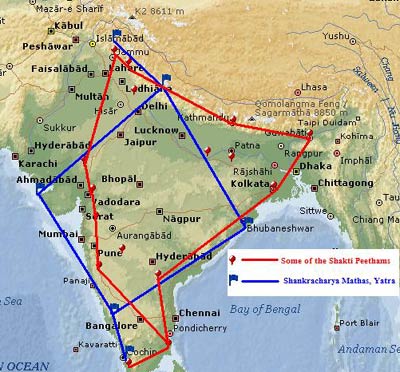
Shankaracharya
Matha Yatra
It
was this idea of civilizational unity and sacred geography of
India that inspired Shankaracharya to not only enunciate the
mysteries of the Vedanta but to go around setting up mathas
circumscribing the land of India in a large diamond shape. While
sage Agasthya crossed the Vindhya and came down south,
Shankracharya was born in the village of Kalady in Kerala and
traveled in the opposite direction for the establishment of dharma.
If this land was not linked in philosophical and cultural
exchanges, and there was no notion of a unified nation, why then
did Shankracharya embark on his countrywide digvijay yatra?
What prompted him to establish centers spreading light for the
four quadrants of this land – Dwarka in the west (in Gujarat),
Puri in the east (in Orissa), Shringeri in the south (Karnataka)
and Badrinath (Uttaranchal) in the north? He is then said to
have gone to Srinagar (the abode of `Sri' or the Shakti) in
Kashmir, which still celebrates this in the name of
Shankaracharya Hill. What
better demonstration that the idea of the cultural unity of the
land was alive more than a thousand years ago?
And
yet, these stories are not taught to us in our schools in India.
We learn instead, in our colonial schools, that the British
created India and
gave us a link language, as if we were not talking to each other
for thousands of years, traveling, telling and retelling stories
before the British came. How else did these ideas travel so
rapidly through the landmass of India, and how did Shankracharya
circumscribe India, debating, talking and setting up
institutions all within his short lifespan of 32 years?
(source:
Why
India Is A Nation - By Sankrant Sanu
- sulekha.com).
The epics, the
Ramayana and the Mahabharata provide a clear example of how the
various regions of
India
were linked by a common culture and awareness. Al-Biruni,
writing about
India
from a place west of the
Indus
, is aware of the centrality of Vasudeva and Rama to the
Indian tradition. All over
India
we find local versions of the Ramayana and
the Mahabharata. They may disagree on the details,
but not on the essentials. Even the regional variants of the
epics show an awareness of the ‘whole’ and not merely of the
region they were composed in. The ‘Great’ tradition of the
Sanskrit epics is mirrored in the ‘little’ traditions, which
are local in their form and yet global in their scope.
Besides this
intimate knowledge of the parts, the Mahabharata
presents a conception of the whole of
India as a geographical unit in the famous passage in the Bhismaparva
where the shape of India is described as an equilateral
triangle, divided into four smaller equal triangles, the apex of
which is Cape Comorin and the base formed by the line of the
Himalaya mountains. As remarked by Cunningham (Ancient
Geography of India, p 5),
“the shape corresponds very well with the general form of the
country, if we extend the limits of India to Ghazni on the
north-west and fix the other two points of the triangle at Cape
Comorin and Sadiya in Assam.” (Mookerji
pp. 62-63).
(source: The
Unity of India - By Dileep Karanth -
svabhinava.org). For
more refer to chapter on Greater
India: Suvarnabhumi and
Sacred
Angkor
Top
of Page
Bali - The Great
Hindu Kingdoms of Indonesia
Bali
is a living museum of the old Indo-Javanese civilization that
flourished on East Java over 400 years ago. Bali today provides
scholars with clues about India's past religious history in old
sacred texts that have vanished in India itself.
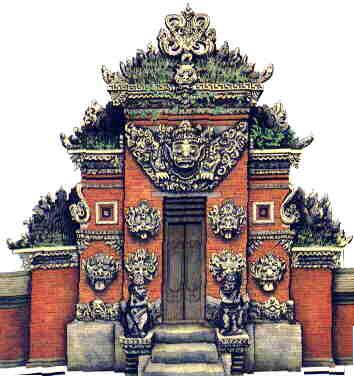 Indonesia, October 8, 2003: This interesting article on the
history of Hinduism in Indonesia ("source" above)
begins, "Over 400 years ago most of East Java was exactly
like Bali is today. Prior to 1815 Bali had a greater population
density than Java, suggesting its Hindu-Balinese civilization
was even more successful than Java's. When Sir Stamford Raffles
wrote his History Of Java in the early 19th century, he had to
turn to Bali for what remained of the once-great literature of
classical Java. Even today Bali provides scholars with clues
about India's past religious life, clues which long ago vanished
in India itself.
Indonesia, October 8, 2003: This interesting article on the
history of Hinduism in Indonesia ("source" above)
begins, "Over 400 years ago most of East Java was exactly
like Bali is today. Prior to 1815 Bali had a greater population
density than Java, suggesting its Hindu-Balinese civilization
was even more successful than Java's. When Sir Stamford Raffles
wrote his History Of Java in the early 19th century, he had to
turn to Bali for what remained of the once-great literature of
classical Java. Even today Bali provides scholars with clues
about India's past religious life, clues which long ago vanished
in India itself.
"Bali first came under the influence of Indic Javanese
kings in the 6th to 8th centuries. The island was conquered by
the first documented King of Central Java,
Sanjaya, in 732;
stone and copper inscriptions in Old Balinese have been found
that date from 882 CE. From the 10th to the 12th centuries, the
Balinese Warmadewa family established a dynastic link with Java.
Court decrees were thereafter issued in the Old Javanese
language of Kawi and Balinese sculpture, bronzes, and other
artistic styles, bathing places, and rock-cut temples began to
resemble those in East Java.
The Sanur pillar (914 CE), partly
written in Sanskrit, supports the theory that portions of the
island were already Indianized in the 10th century. Bali's way
of life was well defined by the early part of the 10th century.
By then, the Balinese were engaged in sophisticated wet- rice
cultivation, livestock breeding, stone- and woodcarving,
metalworking, roof thatching, canoe building, even cockfighting.
The Balinese of the time were locked into feudal genealogical
and territorial bondage. They were subjects of a Hinduized ruler
-- one of a number of regional Balinese princes -- who himself
acknowledged the sovereignty of a Javanese overlord..."
(source:
The
Great Hindu Kingdoms of Indonesia and
Hinduism
Today). For
more refer to chapter on Greater
India: Suvarnabhumi and
Sacred
Angkor
Top
of Page
Hindu organization condemns
discrimination against Dalit student
A Hindu organisation in the US has
condemned reported discrimination against a Dalit student who
was allegedly victimised for offering prayers in a Hindu temple
in India's Andhra Pradesh state.
Navya
Shastra, which professes
spiritual equality of all Hindus, has also promised financial
assistance to Tukaram, 19, to meet his educational costs.
The boy scored a first class in his intermediate examinations
and visited the village temple of Hanuman to make the
traditional coconut offering in Allapur, Andhra Pradesh. When
members of the upper caste community discovered this they
condemned the boy and extorted Rs.500 fine from his apologetic
father, Tulsiram. They also purified the temple by washing it
with cow urine and dung so as to efface the imprints of an
"untouchable," according to Vikram Masson, co-chairman
of the organisation. Such community-based discrimination
continues in India despite a constitutional ban and strict legal
safeguards against community discrimination.
"Tukaram must know that others
in the Hindu world strongly condemn such actions," said
Jaishree Gopal, the other co-chairman of the organisation.
"Navya Shastra will award Tukaram
a scholarship to help his family with Tukaram's educational
costs and sincerely hopes that the Indian government and
religious leaders will pay more attention to the apartheid in
our midst," said Gopal.
(source:
Hindu
organization condemns discrimination against Dalit student -
newindpress.com and Hindu
body condemns discrimination against Dalit teenager
- yahoo.com).
Top
of Page
Fingerprints
of the Gods
Ancient India and Greek legends
It has
long been recognized that India's sacred stories of gods and
goddesses are closely related to those of ancient Greece, Rome,
and the Nordic and Germanic peoples. So similar are
they, indeed, that event the days of the week, both in India and
in the West, continue to be named after the same deities, who
represented the same planets: Sun for Sunday, Moon for Monday,
Mars for Tuesday, Mercury for Wednesday (Woden's day in Norse
legend), Jupiter for Thursday (Thor's day in Scandinivia;
Brihaspati, or Jupiter's day in India), Venus for Friday, and
Saturn for Saturday.
I was being given a guided tour
of the Parthenon in Athens several years ago when my guide
challenged me: "I bet you don't know where the ancient
Greek legends come from."
"From
India," I replied.
She stared at me in astonishment.
"How did you know that? You are quite right, but
very few people are aware of the fact."
(source: The
Hindu Way of Awakening - By J Donald Walters p.
46 - 47). For more refer to chapter on India
and Greece and Hinduisms
influence). For
more refer to chapter on Greater
India: Suvarnabhumi and
Sacred
Angkor
Top
of Page
Vietnam
Festival Includes Ancient Hindu Temple
Cham Village, Vietnam: September 25, 2003: The Cham ethnic
group's Kate Festival opened at the Cham Village in Phuoc Huu
commune, Ninh Phuoc district, Ninh Thuan province, on Wednesday.
The festival, held annually on the first ten days of the seventh
month of the Cham Calendar, is an occasion for the Cham people
to express their gratitude to their God, who is both creator of
the universe and a national hero. Aside from a ritual
performance in traditional Cham costumes, this year's Kate
Festival also includes cultural exchange activities and the
Cham's traditional and modern sporting contests. This contest
will draw 715 Cham athletes and craftsmen from Ninh Phuoc, Ninh
Hai and Ninh Son districts, and Phan Rang-Thap Cham Township.
They will compete in volleyball, football, tug of war and relay
races and traditional sports events such as brocade making and
water jug wearing.
The Cham
culture bred Kate festival is the culture which has been
influenced by Indian culture.
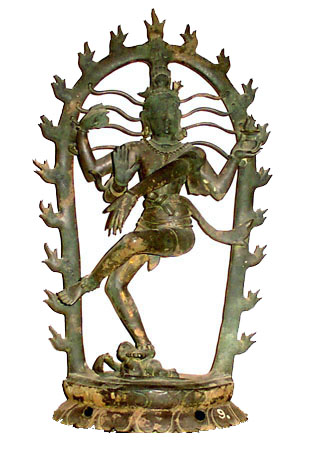 HPI
adds: The yearly Kate festival attracts
thousands of Cham people to the ancient Hindu hill temple of Po
Klaung Gerai. Their brahmin priests perform abhishekam of the
Mukhalinga while Cham music and folk dance are performed in the
temple courtyard. HPI
adds: The yearly Kate festival attracts
thousands of Cham people to the ancient Hindu hill temple of Po
Klaung Gerai. Their brahmin priests perform abhishekam of the
Mukhalinga while Cham music and folk dance are performed in the
temple courtyard.
(source: Vietnam
Festival Includes Ancient Hindu Temple and
The
Cham Festival -
For more refer to
chapter on Suvarnabhumi).
Top
of Page
ShivaBot
Hit of Robot Show
New York City, July 15, 2003: Not all robots look and act like
the Terminator. The idea behind ArtBots, billed as a talent show
for robots, is to show kids of all ages the softer side of bots.
Fear of potentially rabid robots and other supposedly sentient
technology is what motivated ArtBots organizers to host the show
held in New York City recently. The show brought together 23
robots whose talents ranged from creating art to inspiring
affection from passersby. "I thought that there was an
awful lot of attention focused on violent, competitive aspects
of robotics," said Douglas Repetto, one of the curators of
ArtBots: The Robot Talent Show. "It's important to me to
make the point that a given technology doesn't have a given
purpose or application," Reppetto said. "It's humans
who decide what to use technology for and who get to decide how
this technology is applied to their life." Some of the
talents displayed by the robots were pretty impressive. BabyBott
looked like a giant baby bottle and cooed when it was cuddled.
Its talent: making people take care of it. Another robot,
Tribblation, has hundreds of pressure, temperature, sound and
light sensors, enabling it to respond to stimuli like
compliments and stroking. The crowd's
favorite was ShivaBot, a four-armed, 6-foot-tall robot modeled
after the Hindu deity Shiva. ShivaBot, plays electronic drums,
bells, chimes and cymbals.
(source: ShivaBot
Hit of Robot Show and Hinduism
Today).
Top
of Page
Christian
critique of Hinduism
The Brahmins
were identified as the ‘clergy’ or the priests of Hinduism.
An explicit hostility towards the heathen priesthood was not
helped by the inability of the messengers of God’s word to
convert Brahmins to Christianity. In Brahmins, they came across
a literate group, which was able to read, write, do arithmetic,
conduct ‘theological’ discussions, etc. During the first
hundred years or so, this group was the only source of
information about India as far as the missionaries were
concerned. Schooled to perform many administrative tasks, the
Brahmins were mostly the only ones well-versed in the European
languages – enough to communicate with the Europeans. In
short, they appeared both to be the intellectual group and the
most influential social layer in the Indian social organization.
Conversion of the heathens of India, as the missions painfully
discovered, did not depend so much on winning the allegiance of
the prince or the king as it did on converting the Brahmins.
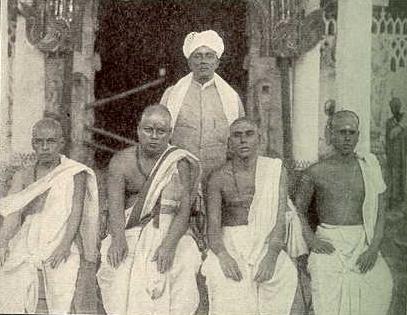
Brahmin
priests at Rameshwar, South India.
***
As Francis
Xavier saw the Brahmins:
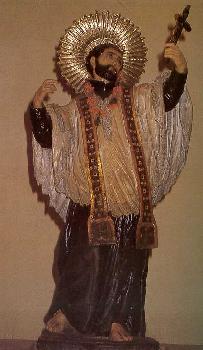 “These are
the most perverse people in the world….they never tell the
truth, but think of nothing but how to tell subtle lies and to
deceive the simple and ignorant people, telling them that the
idols demand certain offerings, and these are simply the things
that the Brahmans themselves invent, and of which they stand in
need in order to maintain their wives and children and
houses…They threaten the people that, if they do not bring the
offerings, the gods will kill them, or cause them to fall sick,
or send demons to their houses, and through the fear that the
idols will do them harm, the poor simple people do exactly as
the Brahmans tell them…If there were no Brahmans in the area,
all the Hindus would accept conversion to our faith." “These are
the most perverse people in the world….they never tell the
truth, but think of nothing but how to tell subtle lies and to
deceive the simple and ignorant people, telling them that the
idols demand certain offerings, and these are simply the things
that the Brahmans themselves invent, and of which they stand in
need in order to maintain their wives and children and
houses…They threaten the people that, if they do not bring the
offerings, the gods will kill them, or cause them to fall sick,
or send demons to their houses, and through the fear that the
idols will do them harm, the poor simple people do exactly as
the Brahmans tell them…If there were no Brahmans in the area,
all the Hindus would accept conversion to our faith."
The
Brahmins, by and large, were unimpressed by the theological
sophistication of the Christian critique of paganism.
Howell,
(1767) wrote that the modern Hindus were "As
degenerate, crafty, superstitious, litigious and wicked a
people, as any race of beings in the known world."
The hatred of
heathen priesthood, and/or priesthood in general; impotence
to convert the Brahmans; an identification of the
latter as ‘priests’; inability to
understand the culture they were functioning in; a supercilious
arrogance born of a bottomless ignorance - these were the ingredients that went into
concocting the charges of duplicity, double standards,
unauthenticity and immorality, against the heathen priestly
caste. (Lach, 258)
As time
progressed, this attack would also target the caste
system.
Missionaries
united in condemning the caste laws – ‘ a lie against
nature, against humanity, against history” – as being
contrary to the spirit of Christian brotherhood; they declared
caste to be the “bane of India”, and demanded that caste
should be utterly rejected by all converts to Christianity.
(Sharpe p. 31).
The ‘caste
system’, together with the priestly caste of the Brahmins,
epitomized all that was wrong with this nation of idolators –
and there were plenty of wrongs to talk about. In 1882, William
Hastie spoke of the Hindu Idolatry and English
Enlightenment (1882 – 30) by describing India as “the most
stupendous fortress and citadel of ancient error and
idolatry…Its foundations pierce downwards into the Stygian
pool.” Hinduism itself was, as he saw it, a mass of “senseless
mummeries, loathsome impurities…every conceivable form of
licentiousness, falsehood, injustice, cruelty, robbery,
murder….Its sublimest spiritual states have been but the
reflex of physiological conditions in disease.”
This
attack was born out of the inability of Christianity to gain a
serious foothold in the Indian society. The
‘red race’ was primitive – it could be decimated; the
‘blacks’ were backward – they could be enslaved; the
‘yellow’ and the ‘brown’ were inferior – they could be
colonized. But how to convert them? One would
persecute resistance and opposition. How to respond to
indifference? The attitude of these
heathens towards Christianity, it is this: indifference.
To some, even
the daily practices of the Jains appeared to be an expression of
abomination and idolatry. The unwillingness or the refusal of
the Jains to hurt or kill animals was, of course, idolatry: “This
people eat neither flesh nor fish, nor anything subject to
death; they slay nothing, nor are they willing to see the
slaughter of any animals; and thus they maintain their idolatry,
and hold it so firmly that it is a terrible thing.” (Dames, )
Christianity
was intolerant of both heretics and heathens. It persecuted
beliefs and practices that ran counter to those of its own. It
fought against those traditions which it construed as rival and
competing religions.
(source: The
Heathen in His Blindness...: Asia, the West and the Dynamic of
Religion - By S. Balagangadhara p.
82 -149). For more refer to chapter on First
Indologists and European
Imperialism). For more refer to The
War against Hinduism - By Stephen Knapp and Indians
Against Christian Aggression.
Top
of Page
Imperial
Plunder? How
the British looted from India and around the Globe
Chhatrapati
Shivaji' sword
The
tussle for the ownership of the 350-year-old Bhawani sword of Maratha
warrior king Chhatrapati Shivaji, which is part of the personal
collection of the Queen of England, has reared its
head once again with Barrister Bhaskar Ghorpade, India's Counsel
in England, deciding to file a petition for its return.
The petition states that the
sword is the cultural heritage of India and is of emotional
value to the people here and hence should be returned as a
"gesture of goodwill" and for cementing ties between
India and England. According
to historians, the famous sword came into the British hands
after the capture of the Raigadh Fort in Maharashtra on June 7,
1818. Mr.
Ghorpade came into the limelight as India's Counsel when he won
the famous Nataraja Case after a prolonged legal battle of 11
years and was successful in retrieving the statue
for the country.
(source: Plea
to be filed for return of Shivaji's sword -
hindu.com).
***
History
For the Taking?
56
years after freedom, Maratha Bhonsles are still fighting Empire
Fifty-six
years after India gained independence from British rule, a royal
family from Nagpur continues to wage its battle against the
Empire. The
Bhonsles are fighting a 150-year-old legal suit against Britain,
and the Lord's Bank of England, in a London court for the return
of illegally sold assets worth billions.
The
seeds were sown in the late 19th century, when the British
attacked Nagpur, then ruled by the Bhonsles. After Bhonsles were
defeated, the British victors turned looters.

56
years after freedom, Maratha Bhonsles are still fighting the
British Empire.
For
more refer to chapter European
Imperialism.
***
An
estimated 14 trucks of Gold and 125 trucks of Silver, apart from
a horde of ornaments, precious and semi-precious stones, rich
treasures, horses and elephants were looted and sent to Kolkata.
Records
reveal that they were auctioned at Kolkata. From their proceeds
was born the Lord's Bank in England!
The
Bhonsles are represented by London's Gandhi Law Firm, Mudhoji
Raje says. During Raghuji Raje's period, the case was even
represented by renowned freedom fighter and social worker Dadabhai
Nooroji,
he adds.
(source: 56
years after freedom, Bhonsles still fighting Empire -
hindustantimes.com).
***
Ethiopian Loot
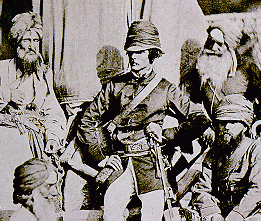 A 300 year old
copy of the Book of Psalms, handwritten in the ancient Ehiopian
language of Ge’ez is displayed in Ethiopia. It was among
hundreds of treasures looted by the British troops from Ethiopia
in 1867 and was recently returned. Ethiopia demands that Britain
return remaining items, which are in British museums. A 300 year old
copy of the Book of Psalms, handwritten in the ancient Ehiopian
language of Ge’ez is displayed in Ethiopia. It was among
hundreds of treasures looted by the British troops from Ethiopia
in 1867 and was recently returned. Ethiopia demands that Britain
return remaining items, which are in British museums.
(source: The
Philadelphia Inquirer – Sat October 4 2003).
Colonial
Arrogance?
Australian
Aboriginal artefacts and a
ceremonial
headdress including two early bark etchings are also in
two British museums. The
fragile bark etchings, which were made in around 1845 by members
of the Dja Dja Wurrung tribe in the Wimmera district of western
Victoria, were part of their cultural heritage. Gary
Murray said: "It's not British culture we are talking about
here, we are talking about our rights as a first nation.
"We believe strongly that they connect us to our country,
our culture and ancestry.
"If
the British found the Crown Jewels in Australia they would be
sending the warships in to get them back."
(source:
UK
exhibits seized in Australia by Aborigines - BBC).
The
Parthenon Elgin
Marble of Greece - background history
It is a travesty to rob a people or a region of its
heritage, and never mind that this is justified today in the
name of globalisation. The argument that Lord Elgin
had legally transferred the marble sculptures is also untenable
since the Ottoman empire no longer exists. The sun has long set on the
British empire and Greece is perfectly capable of taking
responsibility for its national treasures. Would
Britain rest peacefully if, for instance, Nelson’s head was in
some other country, leaving just the torso as part of the
Nelson’s column, asks a “Marble Reunited” campaigner.
Certainly not.
Thomas Bruce,
seventh earl of Elgin, was the British ambassador at
Constantinople in 1799 and he wanted to be of service to the
Arts by making his countrymen more familiar with Greek
antiquities. In 1801 Elgin obtained a firman , or
authority, from the Sultan which gave him permission to take
away any sculptures or inscriptions which did not interfere with
the works or walls of the citadel. The looting of the Parthenon
began immediately. The sculptures were lowered from the temple
and transported by British sailors on a gun carriage. Many
sculptures were removed from the temple of Parthenon and
transported to England. The famous "Elgin Marbles" are
in London now.
"Wouldn't
it be more appropriate, though to see these sculptures in the
context of the Parthenon?" CNN asked. "Isn't
it like seeing sections of Buckingham Palace in
Athens?"
The
Victorians were moved by the fancy that the English were the new
Greeks - rulers of an empire maintained not by brute force but
by moral and intellectual grandeur. Pagan Greeks were appointed
as the ancestors of English muscular Christianity
(source: online
articles and Cultural
treasures belong to their place of origin -
timesofindia.com and cnn.com
and guardian.co.uk).
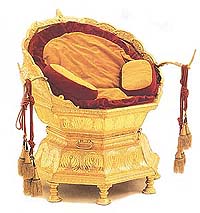 Some
of the artifacts belonging to Maharaja
Ranjit Singh's regime have been displayed at Victoria
Albert Museum, (including his golden throne)
Osborne House and several other museums of Scotland and Britain.
In fact, the British Government has been under tremendous
pressure from several of the sovereign nations, which were once
a part of its Imperial Empire, to return the artifacts and other
valuable items of their historic interest, which the British
had forcibly taken from the then rulers as a
"gift" or otherwise. Besides India and Greece, even
Ethiopia, China and Italy have been pressing the British
Government to return their artifacts. The World Jews Congress
has been demanding 160 artifacts now displayed in various
museums in Scotland. Some
of the artifacts belonging to Maharaja
Ranjit Singh's regime have been displayed at Victoria
Albert Museum, (including his golden throne)
Osborne House and several other museums of Scotland and Britain.
In fact, the British Government has been under tremendous
pressure from several of the sovereign nations, which were once
a part of its Imperial Empire, to return the artifacts and other
valuable items of their historic interest, which the British
had forcibly taken from the then rulers as a
"gift" or otherwise. Besides India and Greece, even
Ethiopia, China and Italy have been pressing the British
Government to return their artifacts. The World Jews Congress
has been demanding 160 artifacts now displayed in various
museums in Scotland.
(source: Tribuneindia.com
and Towards
Balkanisation, III: Missionaries - Varsha Bhosle -
rediff.com).
The Kohinoor
Diamond - Samantik Mani of India
N.
B. Sen writes that the Kohinoor, the king of diamonds and the
diamond of kings, has a legendary origin in the dawn of history,
before the times of the Mahabharat,
5000 years ago. It is the most brilliant and the most dazzling
diamond of the world. Its entire history is linked with
royalties of various countries. Its journey has been confined to
four countries — India, Persia, Afghanistan and England. The
story of the Kohinoor starts from the times of Lord Krishna and
the great battle of Mahabharat
which was fought in 3102 B.C The
original name of this diamond was ‘Samantik Mani’
When
Nadir Shah first saw this diamond he was so much dazzled by its
size, beauty and brilliance that he exclaimed in wonder"
"Koh-i-Noor", which in Persian means " Mountain
of Light". He stole the
fabulous Peacock
Throne and took it to
Iran. For more refer to chapter on Islamic
Onslaught.
This
fabulous diamond was brought to England under the Treaty of
Lahore dated March 29, 1849, and handed over to Queen Victoria
in a ceremony held on July 3, 1850, at Buckingham Palace by Sir
J. W. Logg, Deputy Chairman of the East India Company, in the
presence of Sir John Hobhouse.
(source:
The
Kohinoor, Duleep Singh and his descendents -
tribuneindia.com).
Clive's
Indian stolen plunder fetches 4.7mn pounds
Rare treasures, brought from India by British colonial
commander Robert Clive, were sold for 4.7 million pounds at an
auction at Christie's here. The
highest price was more than 2.9 million pounds paid by an
anonymous bidder for a 17th century jeweled flask which until
recently was on display at the Victoria and Albert Museum here. Cards of the Ganjifa
game, a princely game in which the card decks were often made in
rare materials such as ivory, mother of pearl or gold. Such
cards were but a small part of Robert Clive’s vast booty that
he “collected” in India and took home to England.
(source:
Clive's
Indian plunder fetches 4.7mn pounds
- hindu.com.
For
more refer to chapter European
Imperialism).
***
French
Loot?
The Sancy
Diamond
 Sancy
Diamond,
a 55-carat pale yellow stone that fluoresces yellow and pink. It was found in
the Krishma River in 1701India, passed through French and English kings, was
bought by a Bombay merchant in the 19th century but lost to America's Lady Astor
(who set it on her wedding tiara) before it was retrieved by the French. Current
resting place: The
Louvre. Sancy
Diamond,
a 55-carat pale yellow stone that fluoresces yellow and pink. It was found in
the Krishma River in 1701India, passed through French and English kings, was
bought by a Bombay merchant in the 19th century but lost to America's Lady Astor
(who set it on her wedding tiara) before it was retrieved by the French. Current
resting place: The
Louvre.
The
Regent Diamond
The
Regent, which weighed more than 410 carats when discovered by a
slave near Golconda in the 18th century.
The
bauble was once owned by William Pitt, the English prime
minister, who sold it to the Duke of Orleans, the regent of
France (hence, The Regent). Louis XV
wore it at his coronation and it adorned the hat of Marie
Antoinette.
After
the French Revolution, it was owned by Napoleon Bonaparte who
set it in the hilt of his sword. It is now on display in the Louvre.
(source:
Lost
baubles from India -
timesofindia.com). For more refer to chapter Glimpses
II).
Top
of Page
Elihu
Yale, Yale University
and the Wealth from India
Born in America, in Europe bred,
In Africa traveled, in Asia wed;
Where long he lived and thrived, in London dead,
Much good, some ill he did, so hope all’s even
And that his soul thro’ mercy’s gone to heaven.
Epitaph on the tomb of Elihu Yale - Wrexham, England.
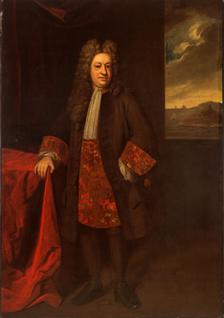 Elihu Yale was born on April 5, 1649 in Boston,
Massachusetts. Yale joined East India Company and traveled to
India in 1672, eventually rising to the rank of governor of Fort
St. George in Madras. Governor Yale’s administrative methods
were, to put it mildly, somewhat forceful. When his groom missed
work for three days, Mr. Yale ordered him to be arrested and
executed. On being, informed that being absent without leave was
not a capital offense, he immediately amended the charge to
piracy and hanged the luckless groom. After serving five years
as governor, Elihu Yale was removed from office for neglecting
his duties and speculating with company funds. By
then he had amassed a huge fortune and
returned to England in 1699, carrying five tons of spices,
precious stones, and leather goods. His departure
must have been a great relief to his domestic staff! A
Connecticut college contacted him in 1718, requesting financial
support. He donated a parcel of goods that sold for 562 pounds,
enough money to persuade the college to change its name to Yale. Elihu Yale was born on April 5, 1649 in Boston,
Massachusetts. Yale joined East India Company and traveled to
India in 1672, eventually rising to the rank of governor of Fort
St. George in Madras. Governor Yale’s administrative methods
were, to put it mildly, somewhat forceful. When his groom missed
work for three days, Mr. Yale ordered him to be arrested and
executed. On being, informed that being absent without leave was
not a capital offense, he immediately amended the charge to
piracy and hanged the luckless groom. After serving five years
as governor, Elihu Yale was removed from office for neglecting
his duties and speculating with company funds. By
then he had amassed a huge fortune and
returned to England in 1699, carrying five tons of spices,
precious stones, and leather goods. His departure
must have been a great relief to his domestic staff! A
Connecticut college contacted him in 1718, requesting financial
support. He donated a parcel of goods that sold for 562 pounds,
enough money to persuade the college to change its name to Yale.
(source: Cuisines of India:
The Art and Tradition of Regional Indian Cooking
– By
Smita Chandra p. 73-74).
Since Yale University was founded in
1718 with the help of a cargo of gift raised in India by Elihu
Yale, who was a governor of Madras it was only appropriate that
it was there that Indian studies in the United States were begun
in 1841.
(source: India and World
Civilization – By D P Singhal p. 225).
For
more refer to chapter European
Imperialism).
Top
of Page
Raga-rocked,
US high on Kirtan craze - By Chidanand
Rajghatta
On
a balmy Friday fall evening, when much of the Washington area is
parrying after a hard week's work, a group of Americans is
gathered at the Willow Tree Yoga Center near Takoma Park, a
funky suburb that is famous for its radical politics and is
often called the home of the ageless hippies. For
long years, this ex-hippie neighborhood just outside Washington
DC has always been into yoga. But more recently, it has added
something else to its spiritual repertoire-kirtans. Yes, kirtans,
the devotional singing invoking the name of gods that comes from
our part of the world. On this day, Willow Tree is hosting Wynne
Paris, a world beat musician who has become one of the most
devoted kirtan singers in the US.
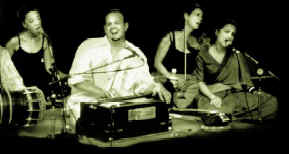 A
long-haired hipster, Paris began his professional life as a
nightclub rocker and evolved into a kir-tan-chanting troubadour
after his wife brought home a CD by Krishna Das four years ago.
Krishna Das, like Paris, is an American whose real name is Jeff
Kagel. He is considered America's first kirtan maestro. Today,
there are a dozen of them, including Shubal-ananda (whose real
name is Larry Cobb), Bhagavan Das (born Michael Riggs), Jai
(Doug) Uttal and Dave Stringer (his real name). A
long-haired hipster, Paris began his professional life as a
nightclub rocker and evolved into a kir-tan-chanting troubadour
after his wife brought home a CD by Krishna Das four years ago.
Krishna Das, like Paris, is an American whose real name is Jeff
Kagel. He is considered America's first kirtan maestro. Today,
there are a dozen of them, including Shubal-ananda (whose real
name is Larry Cobb), Bhagavan Das (born Michael Riggs), Jai
(Doug) Uttal and Dave Stringer (his real name).
The
refined Indian ear might prefer to describe the kirtans
Americans sing as raga rock. They use a mix of Indian and
western instruments, the chanting is innovative (to say the
least), and the accent is definitely American. Paris himself
uses both the guitar and the sarod. Others are known to employ
the violin, mandolin, harmonium, tabla and sundry instruments,
including the electric guitar. Kirtans have been produced in
blue grass, reggae, soul and even rock and roll styles. Raga
rock isn't really all that new. Following their stint with the
Maharishi Mahesh Yogi, John Lennon and George Harrison dabbled
with it as far back as the 1970s in collaboration of Pandit Ravi
Shankar, before the fad faded. But with the resurgence in the US
of all things Indian in the last three or four years, RR has
made a big comeback.
Part
of it has to do with the mushrooming of yoga centers across the
US, including schools that teach new forms of yoga such as
"hot yoga" (jokingly referred to as "hotta
yoga" after the original Hatha Yoga). As Americans have
evolved yoga to suit their needs and whims, they have also
embellished it with all kinds of bells and whistles, including
kirtans and bhajans. Says Paris, "We know it's nothing like
the original, but hey, if it brings us peace of mind, it
works."
It
certainly does, judging by the following the yankee kirtans are
attracting at yoga centers, not just in stressed out urban
areas, but in American suburbia and even backwoods USA. At the
Samadhi Yoga Center in Manchester, Connecticut, attendance for
the four-days-a-week kirtan session has gone up from three to 50
over the past few months. The center now has write-ups on
kirtans in its newsletter called Time and Space. Paris
himself has jammed kirtans at the Holy Cow Yoga Center in
Charleston, Three Rivers Yoga Studio in Houston, Elysian Fields
Yoga in Georgia and the Omkar Ashram in Colorado. He is booked
to perform till the end of the year. Jokes Samadhi Yoga Center
co-founder Matthew Falkowski, who is hosting a grand kirtan
session for Durga Puja next week, "Now we've got to get the
Indians involved in kirtans."
(source:
Raga-rocked,
US high on Kirtan craze - By Chidanand
Rajghatta
-
timesofindia.com).
Top
of Page
City temple
belongs to Mahabharata period: expert
The
Baba Balak Nath temple located on Dakshin Marg, part of a
prized archeological site, according to Mr Devendra Handa,
former head of the Department of Ancient History, Culture and
Archeology of Panjab University.
 “Excavations done at the site in
recent years have conclusively proved that it belongs to the
Mahabharata period and should be preserved as a national
heritage site”, said Mr Handa here today after
going round the temple. Mr Handa said the earliest relics
found at the site were painted greyware, which were nearly 3000
years old and belonged to the Mahabharata period (1000 BC).
“Other relics were found in a running sequence. These included
northern black polished ware (5th to 2nd century BC), Sungha
(second to first century BC) and Kushan period (third and fourth
century BC), early medieval (7th to 12th century AD and also
artifacts belonging to the Muslim period.” “Excavations done at the site in
recent years have conclusively proved that it belongs to the
Mahabharata period and should be preserved as a national
heritage site”, said Mr Handa here today after
going round the temple. Mr Handa said the earliest relics
found at the site were painted greyware, which were nearly 3000
years old and belonged to the Mahabharata period (1000 BC).
“Other relics were found in a running sequence. These included
northern black polished ware (5th to 2nd century BC), Sungha
(second to first century BC) and Kushan period (third and fourth
century BC), early medieval (7th to 12th century AD and also
artifacts belonging to the Muslim period.”
Mr
Handa said that he had also seen several broken sculptures of
Hindu deities of the early medieval period during his visits to
the temple in the early 60s. “These have since disappeared,
which is a sad commentary over the manner sites of historic and
archeological importance are managed and maintained by the
powers that be. It is the same story at the Mansa Devi temple at
Mani Majra. Many of the ancient mural and paintings in the
temple have and incorrect preservation procedures”.
(source:
City
temple belongs to Mahabharata period: expert - A.S.
Prashar
- tribuneindia.com).
For
more refer to chapter on Greater
India: Suvarnabhumi and
Sacred
Angkor
Top
of Page
Martinque
Hindu priest ordained
Nicole
Etiene, 50, of Fort de France, Martinique, will receive the
Upanayan Sanskar (sacred thread) at the Munroe Road, Chaguanas
temple of Pundit Samsundar Ramdeen today. He is among five people who will be ordained
as pundits in the ceremony. Etiene,
whose native language is French, said yesterday that he was
following in the footsteps of his grandmother who was a Hindu
devotee and taught him about the culture. "I was just
attracted to Hinduism," he said. "My late grandmother
was a Hindu and she would practice the rituals. I was interested
in the faith, but did not follow it.
"Three years ago one of my friends invited
me to a Sunday morning service at the Shakti
temple in Martinique and that was it. Since then, I have changed and
began to practise Hinduism." Etiene is the lone Hindu in
his family. The Shakti temple in Martinique is run by Pundit
Ramdeen. He said his siblings have followed the Catholic faith
and Christianity, but he is the only one who has followed in his
grandmother's footsteps. "I wanted to be part of my
family's culture," he said. He
said to him Hinduism was a calling and taking the Upanayan
Sanskar was part of his life's mission. "I did not choose
to become a pundit, it chose me," Etiene said. "I
think it was something inside me that called out to me and I
think this is the right step for me to take.
"At first my family did not agree, but now
they are supporting me in this path. "I am happy to take
this step and happy that my family is supporting me They are now
accustomed to my new way of life. "In addition to being a
vegetarian, they are getting involved also." Etiene also
sees the taking of the Upanayan Sanskar as serving as a
"bond with my ancestors such as my grandmother, who was an
Indian and Hindu, for me." He said he would take all that
he has learned from his Guru Ramdeen and share it with his
fellow Martiniquans. He
also plans to go to France to share the teachings of Hinduism.
(source: Martinque
Hindu priest ordained -
hinduismtoday.com).
Top
of Page
Mount
Kailash - the most sacred mountain in the world.
Poet
Kalidas wrote in the 3rd
Century C.E.:
"When the earth of Manasarovar touches anyone’s body or
when anyone bathes therein, he shall go to the paradise of
Brahma, and who drinks its water shall go to the heaven of Shiva
and shall be released from the sins of 100 births. Even the
beast that bears the name of Manasarovar shall go to the
paradise of Brahma. Its water is like pearls."
Amaury de Riencourt has
written: "India is an immense subcontinent in its own
right, almost as isolated from the rest of the world by towering
mountain ranges rising out of impenetrable jungles and soaring
up to eternal snows – a huge wall, known in the past as Himavat,
stretching like a bent bow from Baluchistan to the wooded
valleys of upper Burma. Here was no mere mountain range like the
others."
"The Himalayas must have seemed to
Indians of thousands of years ago like a colossal outburst of
cosmic anger throwing up tiers of towering peaks on top of one
another or, in another mood, what the great poet Kalidasa called
the “massed laughter” of the god Shiva."
(source:
The
Soul of India – by Amaury de Riencourt
p. 3).
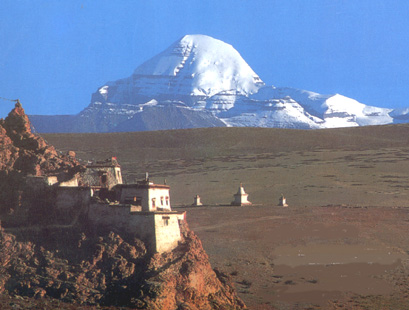
“As the
dew is dried up by the morning Sun, So are the sins of mankind
by the sight of the Himlayas” – Skanda Purana.
***
Mount
Kailash, the adobe of Shiva
and the giant lake of shifting colours - lake Mansarovar. It is
the perfect mountain with awesome
beauty, with 4 great faces. Strangely enough, four
major rivers do indeed originate near Kailash, the Indus, the
Yarlung Tsangpo (Brahmaputra), the Karnali and the Sutlej.
Mt. Kailash has the unique distinction of being the
world’s most venerated holy place at the same time that it is
the least visited. The supremely sacred site of four religions
and billions of people, Kailash is seen by no more than a few
thousand pilgrims each year.
Hindus consider
Kailash to be the throne of Lord Shiva, one of the three
principle gods of the Hindu pantheon, whose long, matted hair
forms the holy Ganges River. Kailash is a glittering snow dome
towering above the Tibetan Plateau like a beckoning jewel,
visible from miles away. Manasarovar is famous as one of the
highest lakes in the world. Four of the greatest rivers of South
Asia -- the Indus, Sutlej, Karnali and the Brahmaputra (the
Yarlung Zangpo in Tibet) -- originate from around Mount Kailash.
There are two lakes here; one the rakshasa tal, where Ravana
performed penances towards Shiva, and the other the Mansarovar,
considered to be one of the 51 Sakth Peethams. A
ritual bath will deliver a pilgrim to Brahma's paradise and a
drink of its water relinquishes the sins of a hundred lifetimes.
It is said that a Single Parikarma erases the accumulated sins
of a lifetime, while 108 circumbulation will achieve Salvation
or Nirvana. Mt. Kailash is regarded by Hindus as an
embodiment of Shiva and Parvati. The Buddhists
refer to the sacred mountain as Kangri Karchchak; they regard
the presiding deity of Mt. Kailash as Deity with three eyes,
holding the damaru and the trishul; his consort is referred to
as Dorje Fangmo. The Jains
regard Mt. Kailash as the Ashtapada mountain where the first
Tirtankara Adinath (Rishabhadeva) attained nirvana.
Mount. Kailash is also one of the highest
mountain in Tibet ( 22,022 ft). Lake Manasarovar lying at 14,950
ft. is the highest fresh-water lake in the world.
***
Other
Sacerd mountains in the World
Spiritual
significance of Uluru in Australia
 In
the beginning the earth was flat and there were no marks on the
land, as the Tjurkurpa people travelled the land they performed
great deeds of creation and destruction. This was still the
creation time and as the waters receded the Mother earth gave
forth a huge rock singular and complete. For thousands of years
this rock stood alone in the heart of Australia, as if
protecting the Mother earth which had given it life. Gaining its
strength and powers from her, vibrating the atmosphere with
innocence and peace. Many
who see Uluru are in awe of its power – to face the rock is to
ask fundamental questions about ones own place in the creation,
for the spirit of man dwells in all men equally. Different races
share different dreams yet the essence of life is common to all
transcending the barriers of time, race, religion and culture.
To deny the spiritual significance of Uluru is to deny the
essence of life within ourselves. In
the beginning the earth was flat and there were no marks on the
land, as the Tjurkurpa people travelled the land they performed
great deeds of creation and destruction. This was still the
creation time and as the waters receded the Mother earth gave
forth a huge rock singular and complete. For thousands of years
this rock stood alone in the heart of Australia, as if
protecting the Mother earth which had given it life. Gaining its
strength and powers from her, vibrating the atmosphere with
innocence and peace. Many
who see Uluru are in awe of its power – to face the rock is to
ask fundamental questions about ones own place in the creation,
for the spirit of man dwells in all men equally. Different races
share different dreams yet the essence of life is common to all
transcending the barriers of time, race, religion and culture.
To deny the spiritual significance of Uluru is to deny the
essence of life within ourselves.
Uluru, the
world's largest monolith and an Aboriginal sacred site is
Australia's most famous natural landmark. Ulluru was renamed as
Ayers Rock for the Premier of South Australia, Sir Henry Ayers.
Mount Fuji in Japan and Denali
- 'the high one' (renamed Mount McKinley) in Alaska are also considered sacred.
The Japanese see Mount
Fuji as a sacred mountain. It was and
still is a destination for pilgrims. Two forms of Goddess
Saraswati in the form of Bensaitensama, commonly called "Benten,"
at the famed island of Enoshima, near Mount Fuji are worshipped.
(source: Spiritual
significance of Uluru). For more refer to chapter
on Nature
Worship).
Top
of Page
Intellectual
poverty in India - or Self - Hate?
Ananda
K Coomaraswamy (1877-1947)
the
late curator of Indian art at the Boston Museum of Fine Arts,
was unexcelled in his knowledge of the art of the Orient, and
unmatched in his understanding of Indian culture, language,
religion and philosophy. He is the author of ' The
Dance of Shiva: Essays on Indian Art and Culture'
"We
who think we are educated and progressive....we ourselves have
despised and hated everything Indian...I do not think we fully
realize the depth of our present intellectual poverty.. The
creative force in us has died, because we had no faith in
ourselves - we could only learn to be intellectual
parasites...."
Kapil
Kapoor, Indian thinker has observed:
"All
this traditional Indian knowledge has been marginalized by and
excluded from the mainstream education system. Efforts to
incorporate it or teach it have been politically opposed and
condemned as "revivalism." Europe's
thirteenth-century onwards successful venture of relocating the
European mind in is classical Greek roots is lauded and
expounded in the Indian universities as "revival of
learning" and as "Renaissance."
But
when it comes to India, the political intellectuals dismiss
exactly the same venture as "revivalism" or
"obscurantism." The educated Indian, particularly the
Hindu, suffers from such a deep loss of self-respect that he is
unwilling to be recognized as such. He feels, in fact, deeply
threatened by any surfacing or manifestation of the identity
that he has worked so hared to, and has been trained to reject.
But it lies somewhere in his psyche as "an unhappy
tale," as something that is best forgotten. It is these
people wearing various garbs - liberals, left, secular,
modern - who oppose, more often than not from sheer
ignorance, any attempt to introduce Indian traditions of
thought, in the mainstream education system - a classic case of
self-hate taking the form of mother-hate."
(source: India
and The New World Culture - By Michel Danino - Hindu
Renaissance - p. 6 - 7). For more on Ananda
Coomarswamy refer to chapter on Quotes101_120).
Top
of Page
Democracy
of a high standard — Ancient example
The
inscriptions on the walls of the Sundaravarada temple in
Uttiramerur, near Kanchipuram, show how democracy was practised
1,000 years ago.
 This
temple was built around 750 A.D. during the Pallava rule, but
underwent a second great renovation in the hands of Rajendra
Chola in 1013 A.D., and again in the reign of the great
Vijayanagar Emperor, Krishnadevaraya in 1520 A.D. The village is
known for its historic inscription of a written constitution
that deals with elections to the village assembly,
qualifications required of candidates contesting in elections,
circumstances under which a candidate may be disqualified, mode
of election, tenure of the elected candidates and the right of
the public to recall the elected members when they failed to
discharge their duties properly and so on. This
temple was built around 750 A.D. during the Pallava rule, but
underwent a second great renovation in the hands of Rajendra
Chola in 1013 A.D., and again in the reign of the great
Vijayanagar Emperor, Krishnadevaraya in 1520 A.D. The village is
known for its historic inscription of a written constitution
that deals with elections to the village assembly,
qualifications required of candidates contesting in elections,
circumstances under which a candidate may be disqualified, mode
of election, tenure of the elected candidates and the right of
the public to recall the elected members when they failed to
discharge their duties properly and so on.
It
is interesting how in every aspect of life the highest standard
of democracy was enforced in Uttiramerur.
Fines
for wrongdoers - A
10th Century record deals with how to administer fines imposed
on wrong doers in the village. Those who were fined for misdeeds
are classified into criminals ("dushtargal"), fined by
the great village assembly and the serving elected members of
the village assembly who were fined.
Testing
gold quality
- Another
record dated 921 A.D. was a regulation passed by the Village
Assembly. As gold was in circulation for commercial transactions
it was found necessary that the gold offered should be tested
for its fineness to the satisfaction of the community.
Appointment
of Professors - Another
interesting record deals with an establishment of a higher
institution of learning and the qualifications prescribed for
the professor, the method of appointment and the duration of his
service. As this was related to a Vedic college, the
qualifications required mastery of the Vedas. For instance, the
incumbent could not be a native of that village but one who came
from other regions. It was believed that the teacher from the
same village might take things easy and not do full justice to
his profession. The second clause states that the teacher should
have mastered one Veda completely in addition to mastery of
grammar, "Mimamsa", and the two religious systems,
"darsanas". Alternately he should have mastered one of
the Vedas, in addition to grammar with commentary ("Vyakarana"
with "bhashya") and Logic with commentary and
classical notes ("nyaaya" with "bashya" and
"tika") and etymological science ("nirukta")
with commentary.
Those
who are conversant with ancient Indian learning know that these
are very high standards compared to this age, where a professor
of Ancient History, for example, need not have even basic
understanding of Sanskrit or epigraphy to interpret the original
sources of ancient Indian culture.
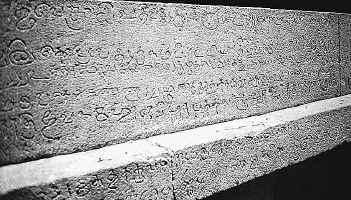
inscriptions
of democracy
Efficient
election system - The salient features were that a
person should have a minimum educational qualification, should
be above 35 years of age and below 70, should own a minimum of
landed property, should have a residence built in his own land
and finally, should be a tax payer. Only such men, who felt it
was their responsibility to contribute to the governance, were
allowed to contest
(source:
Democracy
of a high standard — ancient example - Dr. R
Nagaswamy - hindu.com).
For more refer to article Democracy).
For
more refer to chapter on Greater
India: Suvarnabhumi and
Sacred
Angkor
Top
of Page
Goddess Durga and A
blasphemous picture
Canadian newspaper earns Indians' wrath
A
blasphemous nude picture of Goddess Durga, published by Canada's
leading daily newspaper, The Toronto
Star, has caused widespread
anger and outrage among Indians the worldover.
Indians
living in Canada had expressed their resentment over the
publication of the photograph, made available by the
international news agency, Reuters, by contacting IndiaCause, an
organisation that represents Indians in North America and all
over the world.
The
offending photograph, accompanied a write-up on the occasion of
Durga Puja on the 4 October issue of the newspaper, raises the
doubt if it was an intentional effort to defame the Indian
community. For Reuters had made available four photographs of
Durga to its subscribers - three of them depicting the Goddess
in a decent and clothed manner.
That
The Toronto Star picked up the offending picture of an
incomplete idol has raised the hackles of the Indians, who are
also blaming Reuters for shooting such a picture. Why should the
newspaper go in for the nude photograph when they had a choice
of three other decent ones or even shooting their picture of the
deity from any of the Durga temples in Toronto, asks IndiaCause
that had successfully fought against several such indecent
depictions of Indian Gods and Goddesses by various organisations
- on slippers, toilet closets etc.
 Since
Toronto Star had not bothered to reply to the letter dashed off
by IndiaCause, indicating that the newspaper stood by the
photograph, it wondered if the same paper or for that matter
Reuters would dare to publish a nude picture of Virgin Mary on
Christmas Day.
Those
strongly feeling about the publication of the photograph have
been asked to write to the Attorney General of Canada, Ontario
Press Council, Human Rights Commission, Advertisers of The Star,
Premier Elect of Ontario and Reuters. Since
Toronto Star had not bothered to reply to the letter dashed off
by IndiaCause, indicating that the newspaper stood by the
photograph, it wondered if the same paper or for that matter
Reuters would dare to publish a nude picture of Virgin Mary on
Christmas Day.
Those
strongly feeling about the publication of the photograph have
been asked to write to the Attorney General of Canada, Ontario
Press Council, Human Rights Commission, Advertisers of The Star,
Premier Elect of Ontario and Reuters.
(source:
Canadian
newspaper earns Indians' wrath
- newstodaynet.com).
For
more refer to chapter on Symbolism
in Hinduism.
Top
of Page
An
American's Love for Durga
Anne
Lowenkopf, a California-based American writer, finds Devi
Mahatmyam not only relevant but also useful and
inspirational in the present age.
Of
particular interest to her is the following portion of the
Sanskrit hymns which recount the heroic exploits of Devi Durga
while overpowering the rampaging asuras: "I am all alone in
the world here. Who else is there besides me? See these
goddesses who are but my own powers entering into my own
self." Anne finds the Mother Goddess to be
all-encompassing. According to her, the vision of the loving and
protective mother excites attention today when more and more
young adults live alone, outside family and organised peer
groups. They seem to feel close to a deity who in turn gives
them unconditional love and comfort.
She
is thrilled at her discovery of a "Goddess who did not
punish the created for what went wrong in her creation, who took
the heat for evil and death and yet was untouched by both."
She narrates an incident in which an American — brought up in
the climate of Victorian notions of maternal behaviour — asked
a contemporary devotee of the Devi how he could be drawn to such
a fierce goddess. He was told: "Ah, but you need a strong
mother who will go to battle for you when you are in
trouble."
Shankaracharya
sang the Mother Goddess's praise thus: "Immersed in
dangers, O Durga, I turn my mind to you, O Ocean of Mercy and
spouse of Shiva; please don't consider this as my deceit, since
children remember their mother when they suffer from hunger and
thirst." In the Soundarya Lahari he
underscores Her unique power in the following words: "If
Shiva is united with Shakti, He becomes capable of being
almighty; if not, He is not even able to move His limbs."
There may be a bad son, he says, but never a bad mother.
Vedanta
gives her a cosmic dimension as Jagdamba. As Para Shakti or the
embodiment of infinite energy, she is also the Para Prakriti,
bountiful nature, nourishing us. She symbolises the rationale
for ecological balance and fruitful co-existence. The
shakti-pithas, the holy spots, which are centres of pilgrimage,
are a testimony to the symbiotic ties between the Mother Goddess
and the Mother Earth. These are the places where the various
parts of her body fell when being carried away by an enraged
Shiva, who suffered humiliation at the hands of Daksha, Shakti's
father.
(source: An
American's Love for Durga - timesofindia.com).
Top
of Page
Bangalore
scientist throws new light on the Mahabharata
Analysing the planetary references depicted in the Mahabharata,
a Bangalore-based scientist claimed to have zeroed in on the
period during which the two clans, Kauravas and Pandavas, gained
political power and fought each other in the battle of
Kurukshetra. Based on historical and archeological evidence, the
epic had been dated earlier between 600 to 3000 BC though the
dates have never been proved conclusively.
“The eclipses and planetary observations of the Mahabharata
should belong to 1493 BC to 1443 BC of Indian history. The war
should have taken place in 1478 BC with an error bond of one
year,” Dr R N Iyengar from the department of civil engineering
at Indian Institute of Science in
Bangalore, said.
The analysis was made by calculating planet and star positions
described in the epic in modern astronomical terms using three
software including a German-made one used widely by USA National
Aeronautics and Space Administration for recreating historical
events.
(source: B’lore
scientist throws new light on the Mahabharata -
deccanherald.com and http://www.hindunet.org/saraswati/rniyengar.pdf.
- For more refer to chapter on Hindu
Scriptures).
Top
of Page
Evangelical
zeal not matched by humility, curiosity - By
B. Kumaravadivelu
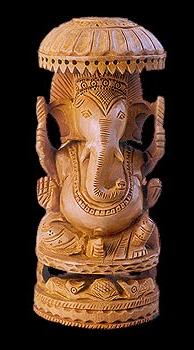 Almost
every Sunday morning there would be a gentle knock at the door.
Two middle-aged women with leather-bound Bibles in their hands, an
unfailing evangelical zeal
in their hearts and a never-fading smile on their faces would be
waiting there wanting to come in. I always ushered them in. Almost
every Sunday morning there would be a gentle knock at the door.
Two middle-aged women with leather-bound Bibles in their hands, an
unfailing evangelical zeal
in their hearts and a never-fading smile on their faces would be
waiting there wanting to come in. I always ushered them in.
My
Sunday sessions with the visiting women usually lasted about 30
minutes, and I started liking the sessions, especially because
they gave me an opportunity to reread the Bible and also
provided a welcome change from my rigorous academic work.A
couple of months later, tired of their sermonizing and
occasional sardonic remarks about Hinduism that revealed how
little they knew about my religion, I thought I should do
something about these weekly encounters.
I
suggested breaking the 30-minute sessions into two parts. "You
talk about Christianity during the first 15 minutes, and I'll
talk about Hinduism the next 15,'' I said. ``That way, we can
learn about each other's religion.''`
`We look forward to next Sunday,'' they promised as they took
leave. That
was the last time I ever saw them.
I
was reminded of these encounters when I read about the latest
``Evangelical Campaign'' in the Family & Religion section of
the Mercury News recently. I learned that more than 100 Santa
Clara Valley churches have come together to convince the
non-Christian residents of the South Bay area that they can make
their lives richer by accepting Jesus Christ as their personal
savior. I was first heartened to read that this new brand of
``friendship evangelism'' is aimed at promoting dialogue in
order ``to draw people into the faith.'' But
then doubts crept in when I read about a San Jose woman, who
recalled her recent visit to an Indian village. "They worshiped
`demons'; they were rock worshipers,'' she said.
Importance
of symbolism
- This
is something similar to a non-Christian, after visiting a church
full of parishioners, saying, ``They worship wooden crosses;
they are wood worshipers!'' Those who understand the
significance of the cross would dismiss such a statement as
uniformed. Symbolism
is an integral part of any religion. You miss the symbolism, you
miss the religion.
(source: Evangelical
zeal not matched by humility, curiosity - By
B. Kumaravadivelu).
For more refer to chapter on Conversion
and FirstIndologists).
Top
of Page
Where
Lord Ram is preach ream and Ravana krong reap
A
primary link between India and Cambodia that dates back over a
millennium is an interesting version of the epic Ramayana, which
has recorded the trials and tribulations of Ram in some 48,000
Sanskrit verses.
The
Reamker, the Cambodian
version of the Ramayana, has a strong Buddhist influence and the
image of Ram, an incarnation of Vishnu, the preserver in
Hinduism's Trinity, has been modified to resemble that of
Siddhartha, who eventually became the Buddha. While the
bas-reliefs of the famous Angkor temples depict several episodes
of the Ramayana, there are also some Buddhist monasteries here
that have preserved some palm-leaf manuscripts of Reamker among
their sacred texts.
"Reamker
in Cambodia dates back to the third century," said Mil
loom, a government-approved guide, who claims to have joined the
profession when he was all of five. "The
Angkor Wat temple has several episodes from the Reamker in the
stone carvings," he added, showing a scene from
the epic depicting a fight between two monkey lords that is
engraved in the temple.
The
temple, which has been conserved and restored by the
Archaeological Survey of India (ASI).

A
primary link between India and Cambodia that dates back over a
millennium is an interesting version of the epic Ramayana, which
has recorded the trials and tribulations of Ram in some 48,000
Sanskrit verses.
***
Interestingly,
the local influence is also evident from the fact that Agni, the
Hindu fire god, rides a rhinoceros in the Cambodian version of
the Ramayana, rather than a ram as in Valmiki's original
Sanskrit edition. The central theme of the epic - victory of
good over evil and the essence of its protagonist s a model son,
emperor, mentor and husband is well preserved in the Reamker.
But it also has innovations not round in Indian versions.
Save
Hanuman, the names of the main characters of the epic stand
either modified or changed altogether. Ram, for example, is
Preah Ream, Lakshman is Preah Leak, Sita is Neang Seda and
Ravana is Krong Reap. The Reamker also has some additional
characters, such as Nil Ek, the aide-de-camp of Ram's trusted
follower and monkey general Hanuman, and Sovann Maccha, the
queen of the mermaids.
Sovann
Maccha first thwarts attempts by Preah Ream's monkey soldiers to
build a bridge over the mighty sea to the land of giant ogres
called Krong Langka, (an adaptation of Lanka in the Indian
epic), where Neang Seda is held captive by Krong Reap. She later
Relents after Hanuman plans to seduce her into supporting his
cause, which is to rescue Preah Ream's wife, Neang Seda, from
the clutches of the 10-headed ruler of Langka, Krong Reap. The
Cambodian version of the Ramayana is among the numerous
adaptations of the epic among Asian nations, just as there are
different versions in India. Hikayat Seri Ram of Malaysia has a
distinct influence of Islam. Thais believe that Ramakein is
their own creation and that Ram was a native of Thailand. In
Myanmar, Ram is described as a pious Buddhist king, while
Tibetans say that Sita was the daughter of Dasagriva, or Ravana.
(source:
Where
Lord Ram is preach ream and Ravana krong reap - By Arvind
Padmanabhan
- timesofindia.com).
For more refer to chapter on Suvarnabhumi
and
Hindu
Scriptures)..
Top
of Page
No Cheers for
Columbus
According to American Historian Will
Durant The Story of
civilizations - Our Oriental Heritage ISBN:
1567310125 1937 p.633:
"From the time of
Megasthenes, who described
India to Greece ca 302 B.C., down to the eighteenth century, India was all a
marvel and a mystery to Europe. Marco Polo (1254-1323) pictured its western
fringe vaguely, Columbus blundered upon America in trying to reach it, Vasco da
Gama sailed around Africa to rediscover it, and merchants spoke rapaciously of
"the wealth of the Indies."
***
 Venezuelan President Hugo Chavez urged Latin Americans on
Saturday not to celebrate Columbus Day, saying the 1492
discovery of the Americas triggered a 150-year "genocide"
of native Indians by foreign conquerors who behaved "worse
than Hitler." Venezuelan President Hugo Chavez urged Latin Americans on
Saturday not to celebrate Columbus Day, saying the 1492
discovery of the Americas triggered a 150-year "genocide"
of native Indians by foreign conquerors who behaved "worse
than Hitler."
"Christopher Columbus was the
spearhead of the biggest invasion and genocide ever seen in the
history of humanity," the populist president
told a meeting in Caracas of representatives of Indian peoples
from across the continent. Columbus Day on Oct. 12 is celebrated
as a holiday in the United States and several Latin American
nations, but Chavez said it should be remembered as the
"Day of Indian Resistance." "We Venezuelans, we
Latin Americans, have no reason to honor Columbus," he
added.
The Venezuelan leader said Spanish, Portuguese and other
foreign conquerors had massacred South America's Indian
inhabitants at an average rate of roughly "one every 10
minutes." He described Spanish conquistadors like Hernan
Cortes and Francisco Pizarro, as "worse than Hitler." He
said even the continent's geographical names, like America and
Venezuela, were imposed by foreigners.
(source: No
Cheers for Columbus - yahoo.com).
For more refer to chapter India
on Pacific Waves?
Anti-Columbus
protests were held recently on the campus of New York's Cornell
University with students accusing the 15th century
explorer of being responsible for the murder of more than 12
million Indians and participating in the Caribbean slave trade.
"Without taking a look at our human history, genocide could
happen again," said Jason Corwin, media assistant for
Cornell's film program, according to the student newspaper The
Cornell Daily Sun.
Lloyd Elm, an
American Indian studies professor at Cornell
University, reportedly told the anti-Columbus rally that "traditional
American schools sanitize information" and many
students are led to believe that "the history of this
great, great, country began in 1492."
(source:
Columbus'
Critics Blamed for Pointing Fingers at Whites - By By
Marc Morano).
Top
of Page
Jewish
settlement in Kerala
“Hail and
Prosperity! The following gift was graciously made by him who
has assumed the title of
King of Kings! …To Joseph Rabban
Prince of Anjuvannam and to his descendants…so long as the
world and moon exist. Anjuvannam shall be his hereditary
possession. Hail!
-
Proclamation of King Ravi Varman,
10th century A.D.
The Jewish
settlement at Anjuvannam in Kerala, has established on land
granted by King Ravi Varman, grew into an independent
principality, which the Jews called Shingly,
that survived for more than five centuries. The Jews prospered
as pepper traders in Kerala, but the tiny domain given to them
“so long as the world and moon exist” did not survive. An
attack by Arabs in the 15th century almost destroyed
their city. Even more hostile were the Portuguese, who had
recently arrived in India and persecuted the Jews mercilessly.
The survivors fled to the Hindu kingdom of Cochin, where they
were welcomed by the king and given land next to his own palace.
Their descendants still live in the Jewish community that was
rebuilt in Cochin in 1567.
Later Jewish
immigrants to India came mainly from Iraq and Syria; Indian
Jewish cuisine and customs are an interesting mix of Jewish,
Kerala and Arab traditions. The festival of Purim coincides with
the Hindu celebration of Holi, and Jewish children adopted the
Hindu custom of dousing each other with colored water.
(source: Indian
Jews and their heritage - hindu.com).
Top
of Page
How
US Schools Misrepresent Hinduism! - Contributed By Rita Frenchman Gavankar
It's 8:00 a.m., and students slowly trickle into Mr. West's 6th
grade history class.
The majority of the people, including the teacher, are white.
One African-American, two Orientals, and myself, a second
generation Indian girl, make up the rest of the class.
On the blackboard is written "World
Religions."
As the rest of the class prepares for a boring two hours, I can
already feel my stomach sink - what did I do to deserve this? We
are handed a fill-in-the-blank chart of major world religions
and are instructed to look in our books for the answers.
 Finishing quickly, I hand in my chart to Mr. West at his desk,
and turn to leave. "Now
wait a minute, you put 'monotheistic' down for Hindooism,"
he remarks.
Finishing quickly, I hand in my chart to Mr. West at his desk,
and turn to leave. "Now
wait a minute, you put 'monotheistic' down for Hindooism,"
he remarks.
"I know," I reply, feeling my face burn as the class
looks up. "Hindoos are polytheistic." "No,
they're not," "Are you a Hindoo?"
"Yeah." "Oh." Scattered murmurs break
out among my peers, whispering about how freaky Hindus worship
elephants and monkeys. Great.
"Well," Mr. West says standing up and going to the
chalkboard, "from what I understand, Hindoos
are all about their caste system."
And he begins a long, irrelevant, and incorrect explanation,
which he memorized from our textbook.
What
does that have to do with being monotheistic?
I don't even bother correcting him, to save myself any more
embarrassment. I wanted to get out of there. Fast.
7th
grade starts, and it's culture day in history.
"Both of my parents are Indian--" I begin when it's my
turn. "Do you mean Native American Indian, or Middle
Eastern Indian?" my teacher asks. Sounds like it's going to
be another fun year in social studies.
When 8th grade starts, India
and Hinduism are summed up in a few short sentences by the
teacher. India is described as filled with pollution, cows, and
poverty-stricken people. Hindus love to bathe in rivers where
they throw the ashes of their parents and yes, they do worship
elephants and monkeys.
"Do you speak Indian?" I'm asked at least two times a
week. "I heard there were two thousand gods and every full
moon you had to give a sacrifice to them. Do you do that?"
No. I try to explain that all the gods are really aspects of one
almighty being. I've never sacrificed anything except my
dignity, which slowly dwindles with each question. The release
of popular award-winning books such as Homeless Bird, which
portrays the typical Indian girl who is forced to get married at
thirteen, didn't help Indians anywhere.
And, who could have guessed, the
author hadn't even been to India! No kidding.
Six entire chapters in the textbook were devoted to
Christianity, whereas one page is given to the history of India
and the teachings of Hinduism. A second page is entirely about
Lord Shiva, accompanied by a rather unbecoming picture of an
ancient dancing Shiva statue. Buddhism gets one paragraph. This
doesn't make sense, as most of the school already knows so much
about Christianity, but hardly any even knew Buddhism or
Hinduism existed. Now that they did, we would be ridiculed
publicly. Thank you, Board of Education.
 At
last, high school starts. I almost die of shock when I see the 9th
grade textbook
has devoted an entire 3 sentences to Sikhism and Jainism. It
claims Sikhism "combines the Muslim belief of one god with
the Hindu belief of reincarnation."
Christianity in India and the ever-popular "western
influence" get pages and pages of text. At
last, high school starts. I almost die of shock when I see the 9th
grade textbook
has devoted an entire 3 sentences to Sikhism and Jainism. It
claims Sikhism "combines the Muslim belief of one god with
the Hindu belief of reincarnation."
Christianity in India and the ever-popular "western
influence" get pages and pages of text.
But the fun just gets funnier -- the next picture of a sari
earns a whole two sentences. Oh, but it's not an exquisite silk
or glittering embroidered sari. Nope, it's a dirty yellow
(perhaps once white) cotton sari worn by an old woman bathing in
the Ganges River.
In spite of its pollution, "Hindus readily drink and bathe
in the Ganges' water people even come to die in the river."
To further prove their point, they stick in a picture of a filth
and trash laden section of Ganges, not a clean part, which much
of it is. I kid you not, upon reading this and looking at the
picture, a boy in my class had to be excused to the nurse's
office because his stomach had become queasy.
Now we come to the sacred
cow.
They say entire streets are blocked because Hindus don't want to
run over our beloved cow. C'mon, even in America, people aren't
going to just run over a local cow; they'll find a way to move
it or get around it.
On
an ending note,
Indians are technologically behind. They fail to mention that we
have a space program, nuclear capabilities, and many Indians,
believe it or not, have heard of a computer. Every
day, young desi children and teenagers are unreasonably
tormented because of our perceived background. The school
textbooks are half the cause. The
average American doesn't know squat about India, and with the
help of poorly researched textbooks, they learn nonsense.
(source: How
US Schools Misrepresent Hinduism! -
By
Rita Frenchman Gavankar - Hindu Unity.org).
Top
of Page
India
a major threat to US dominance: Intel chief
Observing
that India and China are 'key threats' to continued American
dominance in important high technology sectors, Intel Chairman
Andrew S Grove has said India could surpass America in software
and tech-service jobs by 2010.
India's
booming software industry, which is increasingly doing work for
US companies, could surpass America in software and tech-service
jobs by 2010, Grove, one of the founding fathers of America's
hi-tech industry and co-founder of Intel, told a global
technology summit in Washington via satellite on Thursday. He
said that the nation's software and service businesses are under
siege by countries like India and China taking advantage of
cheap labour costs and strong incentives for new financial
investment.
(source: India
a major threat to US dominance: Intel chief
- rediff.com).
Top
of Page
Welcome
the rise of China and India - By Roger Bootle
We
are entering a period when the rise of China and India will
radically reshape the location of economic activity across the
world. This is the Great Displacement. It is the modern
equivalent of the development of North America in the 19th
century - only bigger.
History
lesson
The
top chart shows the shares of world GDP for China, India and the
UK from 1500 to the present. According
to the great authority, Angus Maddison
(author of The
World Economy: A Millennial Perspective) in 1500, China and India
each accounted for about a quarter of the world's output and the
UK for only about 1 per cent.
By
the early 19th century, although India had already begun its
long relative decline and the UK its long relative ascent, India's
economy was still some three times the size of Britain's.
Once
I had grasped it, this fact immediately solved something that
had puzzled me for years, namely how
could the conquest of India have meant so much for Britain?


India's
economy was still some three times the size of Britain's.
***
After
all, in the modern world, although it has had a huge population,
India has had a smaller economy than the UK. But
not in the 19th century. In relative terms the Indian economy
was enormous. You can readily see how the control of such a
large economy by a small set of islands off the European coast
was such a sensation. No wonder India was the jewel in the
crown.
For
more refer to chapter on
European
Imperialism, Seafaring
in Ancient India).
For more refer to chapter on Greater
India: Suvarnabhumi and
Sacred
Angkor
China,
of course, was never formally part of anyone's empire, but for
much of the 19th century she was dominated by the Western
powers, including Britain, and again the chart shows why she was
such a tasty morsel for them to pick over. In
the 20th century her relative decline continued, spurred by
decades of bad government, unrest, war, civil war and finally
communism. This culminated in a period of economic madness
and self-destruction under Mao which has no parallel in history.
In 1950 China's GDP was below Britain's. But the recent past is
a highly misleading guide to China's latent strength. And now
China is on the way back.
(source: Welcome
the rise of China and India - telegraph.co.uk
- 12/10/03).
Top
of Page
Benisagar:
A 5th Vedic Hindu University
This university possibly never found a mention in Huien Tsang's
memoirs.But around the same time the great Chinese traveller-scholar
was laying bare the tenets of Buddhism to his students at
Nalanda University, a few hundred miles to the south, devout
Hindus were absorbed in studying the four Vedas, a recent
archaeological find suggests.

The
5th century AD Brahmi script denotes the Sanskrit language. The
seal recovered from Benisagar indicates that it was a seat of
learning where the four Vedas were taught.
***
Evidence
of a 5th Century AD Vedic Hindu university located at Benisagar
village in West Singhbhum district (bordering Mayurbhanj in
Orissa) has recently been unearthed by archaeologists.
According to Mr Onkar Chauhan, archaeological superintendent of
the Ranchi Chapter of the Archaeological Survey of India, the
findings are based on the recovery of a seal, which bears
characters of the Brahmi script belonging to the Gupta era. Mr
Chauhan told The Statesman that the seal was discovered from the
rain gullies of an ancient mound in August this year and is
currently in the possession of a local villager. The seal, which
is circular with a linear border, has a horizontal line
bifurcating the motifs and the legends. The motifs are depicted
on the upper half while the legends lie on the lower half. The
motifs, according to Mr Chauhan, represent rosary beads,
kamandalu and danda, while the legends comprise nine letters. It
reads: Priyangu Dheyam Chaturvidya,
translated, one who is well-versed in the four Vedas. The 5th
century AD Brahmi script denotes the Sanskrit language.
Mr Chauhan said the archaeological remains of the place consist
of low mounds, ruins of bricks and stone temple, apart from
phallic and stone images. The mounds are scattered all over the
area, but the many-layered remains converge at a particular spot
known as Devasthan on the eastern embankment of a large tank -
Benisagar - from which the village derives its name. The
discovered seal is one that belonged to Brahmins. Mr Chauhan
said that the large number of private seals discovered during
excavations of Bhita and Basrah regions in Kutch bear
resemblance to the Benisagar seal. In both cases, the script
character used in the inscription measures 1.5 inches. While the
Kutch seal dates back to the 8th century AD, the Benisagar seal
belongs to the 5th century AD.
Researches revealed, the Vedic systems of learning were
prevalent between 1st and 11th century AD. The four education
systems included Charan, Agahara, Travidya and Chaturvidya. The
seal recovered from Benisagar indicates that it was a seat of
learning where the four Vedas were taught.
(source: Benisagar:
A Nalanda contemporary seat of learning - Statesman
News Service - October 18
2004).
Facts
about Benisagar - This is situated in the border of
West Singhbhum & Orissa.The
place was named after the king Beni. This is famous for
archaeological findings. The famous Khiching temple relate to
the king Kichak of Mahabharat. According to local belief the
Pandavas spent sometime over here during their Agyant Baas.
Top
of Page
Can
You Sing Om? - By
Michele Orecklin
Western practitioners are putting
a new spin on the call-and-response yogic chant known as kirtan
Even if he
wanted to, the musician who calls himself Krishna Das could not
hide the fact that he was born on Long Island as Jeff Kagel. For
one thing, there's his undeniably white skin, and when he sings
in Hindi or Sanskrit, he does so with an undeniably American
accent. But Das, who is known as K.D., has no desire to hide his
New York roots or the fact that his musical style owes as much
to the blues as to his Indian guru, Neem
Karoli Baba (1900-1973).

Neem
Karoli Baba (1900-1973).
K.
D. is a practitioner of kirtan,
devotional chanting, which originated as a component
of the religious form of yoga known as Bhakti and is conducted
by call and response. Chanters repeat short phrases over and
over, invoking the names of Hindu gods. With the current embrace
of all things yogic in this country, the ancient ritual is
enjoying a vogue, and as practiced by K.D. and other prominent
American performers, it has taken on a decidedly Western slant.
While Jai Uttal (ne Doug Uttal), Bhagavan Das (born Michael
Riggs) and Dave Stringer (his real name) chant in Hindi and
Sanskrit, all incorporate Western instruments and melodies on
their CDs and in their live performances at yoga centers and
small arenas around the country.
In
addition to the traditional accompaniment of harmonium and tabla
(Indian drums), Stringer employs electric guitars and violins.
"You can sing chants the way they are sung in India,"
says K.D., whose last album, Door of Faith, was produced by
kirtan devotee Rick Rubin, who has worked with Johnny Cash and
the Beastie Boys.
"It's empowering to sing
with others who experience the process with you," says
Reed. Greg Wendt, a financial adviser in Los Angeles, explains
that kirtans allow him to "spend time with people on a
spiritual path and share that passion with our voices."
Wendt
says that when he chants, "the stress melts in my body and
I feel this opening in my heart." Georg Feuerstein, founder
of the Yoga Research and Education Center near Redding, Calif.,
says kirtan is an exclusively Hindu practice in which believers
praise gods to whom they are devoted.
(source: Can
You Sing Om? - By
Michele Orecklin - time.com).
Top
of Page
Funds for Conversions in Kalpana's
name?
 Kalpana
Chawla, the Indian astronaut who died tragically in the Columbia
spacecraft crash, may be a heroine for many in the country. But
to a Christian group, operating a trust from Tamilnadu, her name
is good enough to raise funds. Though the trust has
not specified for what it is raising the funds, speculations are
rife that it could be for conversion activities. Kalpana
Chawla, the Indian astronaut who died tragically in the Columbia
spacecraft crash, may be a heroine for many in the country. But
to a Christian group, operating a trust from Tamilnadu, her name
is good enough to raise funds. Though the trust has
not specified for what it is raising the funds, speculations are
rife that it could be for conversion activities.
The
Trust, under the name Scot Christian
Trust operating in Bodinayakanur in Theni district,
has been soliciting funds especially from the rural public in
the State under the pretext of collecting money 'to feed her
family'. Kalpana has also been described as a space scientist in
the soliciting material. The trust has put out notices (clumsily
written ones) saying that, 'due to space craft accident
(Columbia), we (India and all the people of India and Kalpana
Chawla's family) have (been) startled, her family had a great
loss and also our country had lost a great space scientist.
'To
feed her family, we are gathering donations all over the world,
to help her family. So you kindly send your donations to the
below address by cash or D.D or Cheque (for your donations tax
deduction is applicable): Scot Christian Trust,125, P.H.Road,
Thendral Complex, Bodinaykanur - 625 513. Theni Dist. Tamil Nadu,
South India. E-mail: scotchristiantrust@yahoo.co.in Secretary :
Jayascot@yahoo.co.in Fax: 0091(4546) 281838.'
Kalpana
should be surely turning in her grave. If
her life was an exploration in the sky, her death to some seems
to be an exploitation in earth.
(source:
Funds
for conversions in Kalpana's name? -
newstodaynet.com). For more refer to chapter on Conversion).For more refer to The
War against Hinduism - By Stephen Knapp).
Refer
to VINDICATED BY TIME: The Niyogi Committee Report On
Christian Missionary Activities -
Christianity
Missionary Activities Enquiry Committee 1956
and
The
Sunshine of Secularism.
***
Singing
Hindi devotional songs to the Lord Rama and ringing brass bells
in ritual, about 300 people gathered Sunday afternoon at the Hindu
Temple and Community Center in Sunnyvale
to remember Kalpana Chawla and six other astronauts who perished
in the space shuttle Columbia. ``She was not only an astronaut;
she was a daughter of India. She was one of our own,'' said Raj
Bhanot, co-founder of the center, one of the largest Hindu
temples in the South Bay. A scholarship fund in honor of Chawla
has been established at the temple, drawing an initial $2,000
donation at Sunday's gathering.
Chawla
attended the temple in the early 1990s when she was a research
scientist with NASA at Moffett Field, developing
three-dimensional simulations of air flows.
Those who knew her at the temple marveled at the trajectory of
her life, from a determined schooling in a village in India, to
the pursuit of her dream to fly. She became the first
Indo-American to go on space missions.
(source:
Daughter
of India' honored)
Top
of Page
White
hand on our nuke button? -
By Tavleen Singh
 As
a steadfast member of the school of political thinking that
totally opposes foreign prime ministers for India I never fail
to take up the issue whenever it slips back into the news.
Ignoring Sonia’s foreignness is about as difficult as ignoring
a boil on someone’s nose and yet we ignore it totally these
days. It is my view that we will have to pay a very heavy price
for this which is why, despite hate mail and admonitions from
Congress friends, I rake up Sonia’s foreignness any chance I
get. As
a steadfast member of the school of political thinking that
totally opposes foreign prime ministers for India I never fail
to take up the issue whenever it slips back into the news.
Ignoring Sonia’s foreignness is about as difficult as ignoring
a boil on someone’s nose and yet we ignore it totally these
days. It is my view that we will have to pay a very heavy price
for this which is why, despite hate mail and admonitions from
Congress friends, I rake up Sonia’s foreignness any chance I
get.
I
was wandering about Rajasthani villages conducting the usual
pre-election vox populi. Naturally, one of my questions was
about Sonia’s foreignness. In the drawing rooms of Delhi and
Mumbai the ‘‘educated’’ view is that the ‘‘common
man’’ thinks Italy is a village in Tamil Nadu. Happily, most
of the people I talked to knew exactly where Italy was and
said
they did not like the idea of a foreign prime minister one bit.
It was wrong, they said, an insult to national pride.
So,
when I hit urban terrain and came upon the sanctimonious
editorials in the national press I was quite taken aback.
To
me it came as a reminder that the ‘‘common
man’’ is some times wiser politically than those of us who
think of ourselves as uncommonly well educated. In the Sonia
context he is wiser because instinctively he appears to
understand that India becomes a global joke the day we elect an
imported leader. Who will take us seriously? But,
there are more serious reasons why Sonia’s foreignness will
never be a ‘‘non-issue’’ and these relate — as this
column has pointed out before — to matters of governance.
Think
of how much more we regress if our only reason for choosing a
foreigner for the most important job in the country is that she
married into a political family. Why do we laugh then at Rabri
Devi? Surely, she is more qualified than Sonia for high public
office. She is at least Indian by birth. Speaking of which why
is it that so few people remember that the lady who seeks to be
our next prime minister has only recently
acquired her love for India. How else to explain why, despite
being the Prime Minister’s daughter-in-law, she chose to
remain a foreigner till 1983 when her husband’s decision to
enter electoral politics made an Italian wife a serious
inconvenience. As it is when times got bad he was sneered at as
Italy ka daamad.
Think
of how much worse it will be if Sonia — heaven forbid —
should make it to the Prime Minister’s office and times get
bad? What if there is another war with Pakistan, can you see the
Army chief reporting to a foreigner? Think of the answer to that
question in the context of marriage to foreigners being
forbidden to Army officers till not so long ago. Think of it
also in a nuclear context and remember that it is the Prime
Minister’s hand on the button.
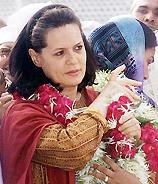 Beneath
our supposedly civilised veneer let us not forget that every
Indian child grows up being taught about the foreigners who
ruled us for a thousand years.
A colleague recently tried to count the number of columnists who
openly opposed the idea of a foreign prime minister and, would
it surprise you if I said, that he did not get beyond the
fingers of one hand. Beneath
our supposedly civilised veneer let us not forget that every
Indian child grows up being taught about the foreigners who
ruled us for a thousand years.
A colleague recently tried to count the number of columnists who
openly opposed the idea of a foreign prime minister and, would
it surprise you if I said, that he did not get beyond the
fingers of one hand.
Is it any wonder
that foreigners found it so easy in the past to subjugate
us?
(source:
White
hand on our nuke button? - By Tavleen Singh -
indianexpress.com). For
more refer to chapters on Islamic
Onslaught and European
Imperialism).
Secularism
and Sonia Gandhi
Secularism
is our destiny,’’ she said loftily to a Delhi newspaper. She
explained what she understood secularism to mean.
‘‘Secularism in the sense of equal respect for all
religions, in the sense of combating communalism of all kinds,
in the sense of giving minorities safety, security and equality
of opportunity.’’
Secularism does not mean any
of these things. It is a European word that relates to
separating the church from the state and in that sense
irrelevant in India since no Shankaracharya ever ruled or had an
army, as the Vatican once did,
But, Congress gets away
with occupying the ‘‘secular’’ high ground because 50
years of propaganda have brainwashed most of our thinkers,
academics and hacks into believing a lot of nonsense about
communalism and secularism.
(source:
Blame
Cong for rise of Hindutva - By Tavleen Singh -
indianexpress.com).
Sonia
in politics - A national disaster - By S Gurumurthy
Some
of you may even say I am a racist. I was discussing this issue
with Cho Ramaswamy. He told me something he may not write but I
will share this with you. Cho said, and I quote, "If
Sonia Gandhi had been black, had been a person of African
origin, this problem would never have arisen."
Do
you understand what this means, unpalatable though it may be to
some of you? It is this fascination for
the white skin and it is we, the English educated Indians, who
are responsible for this. Tamil patriot and poet Bharathi said,
" Ayiram undingu jathi, enil anniyar vanthu pugal enna
neethi. " Yes, we may have hundreds of castes but that is
no reason for an alien to fish in our troubled waters and play
arbiter here. That is what Lokmanya Tilak mean by Swaraj first.
We may fight among ourselves, we may even kill each other, but
we don't want a foreign arbiter.
(source: Sonia
in politics - A national disaster - By S Gurumurthy - sify.com).
Sonia,
our Lady of Renunciation?
With the
clamour in her ears comparing her to Jesus and the Buddha and
the pathetic paeans of her courtiers in the media, it would have
been easy not to notice the groundswell of shock and shame.
The modern equivalent was SMS and messages went like this in
Hindi.
Ab
to khush ho na Hindustani? Raj karegi imported rani/217 hijdon
ne ek videshi ko di kamaan, ab kabhi na kehna mera Bharat Mahaan.
(source:
Perhaps
Sonia was wiser than we think - By Tavleen Singh -
indianexpress.com).
Are you as confused
about who rules India as I am? Puzzled that although Santa
Sonia, our Lady of Renunciation, so graciously handed the reins
of power to her chosen subordinate, we still see much more of
her than we see of him. When
our friendly neighbourhood military dictator wanted to continue
the dialogue initiated by the Vajpayee government, he also
seemed not to notice that it was bad protocol to invite the
Congress president to Pakistan when the Prime Minister is
someone else.
There
is something about the Gandhis that has always (except briefly
during the Emergency) inspired this kind of sycophantic drivel..
My problem is that I appear to be among a small handful who do
not see any renunciation. Quite the opposite. It seems to me
that Sonia has managed to put herself in the wonderful position
of being all powerful without any accountability.
(source:
The
de facto PM – By Tavleen Singh - indianexpress.com).
Abrupt
renouncer to gradual usurper, Sonia's U-turn?
When
she announced she had renounced, the entire herd of Congress MPs
fell at her feet to the full view of the world on free-to-air
telecast. Thus she renounced, not silently, but thunderously.
She announced this on Tuesday, May 18, late evening.
The
media first called it a drama, went wild with admiration as it
turned true. `Gandhi, the Mahatma', ‘Saint Sonia',
‘Vedantic' renunciation' - the media turned hysterical thus.
Soon
she became the chairperson of the United Progressive Alliance.
One week later she was appointed as the head of the National
Advisory Council, a new body created to position her above the
PM. She was given a Cabinet rank. She would get an office in
Vigyan Bhavan, the best building in the Capital. Three days back
the Law Minister announced that she could call for any file.
This virtually made her the Super PM, almost officially.
(source: Abrupt
renouncer to gradual usurper, Sonia's U-turn?
- By S Gurumurthy).
Top
of Page
Multinationals
Eyeing Patent On Rudraksha?
Rudraksh is formed by association
of two words, 'RUDRA' and 'AKSHA" . Rudra is the name of
Lord Shiva. Aksha means 'tear'. It is said that the plant of
Rudraksh is originated from the tear drops of Lord Shiva.
***
 Kochi, India, October 5, 2003: A multinational pharmaceutical
company is understood to have initiated steps to gain patent
rights over rudraksha, the seed of the tree known as Elaeocarpus
ganitrus, in botanical terms. Another international jewelry firm
has reportedly come up with diamond-studded rudraksha ornaments,
says this article. The rudraksha seed
is used in Ayurvedic medicines for curing psychiatric disorders,
hypertension and gastrointestinal diseases. The tree
is generally found in the Himalayas, Nepal, Varanasi etc. The
medicinal values of rudraksha are mentioned in Ayurvedic texts
such as `Ashtanga Hrudayam', according to Ayurvedic doctors. The
fully-grown fruit in dried form, known as bead, appears in
multi-faces or 'mukhas' due to the dividing lines from one side
to the other. The value of the rudraksha depends on the number
of faces it possesses.
Kochi, India, October 5, 2003: A multinational pharmaceutical
company is understood to have initiated steps to gain patent
rights over rudraksha, the seed of the tree known as Elaeocarpus
ganitrus, in botanical terms. Another international jewelry firm
has reportedly come up with diamond-studded rudraksha ornaments,
says this article. The rudraksha seed
is used in Ayurvedic medicines for curing psychiatric disorders,
hypertension and gastrointestinal diseases. The tree
is generally found in the Himalayas, Nepal, Varanasi etc. The
medicinal values of rudraksha are mentioned in Ayurvedic texts
such as `Ashtanga Hrudayam', according to Ayurvedic doctors. The
fully-grown fruit in dried form, known as bead, appears in
multi-faces or 'mukhas' due to the dividing lines from one side
to the other. The value of the rudraksha depends on the number
of faces it possesses.
Subas Rai, a
researcher at the Benaras Hindu University, has published a
book, `Rudraksha -- properties and biomedical implications'. He
had studied the magnetic properties, inductance and capacitance
of the beads.According to Mr. Rai, ``electrical signals over the
body surface vary from region to region and differ for both
halves of the body due to varying magnitude of ionic currents
involved in the functioning of different cell tissues, nerves
and organs. Fluctuation in these signals beyond certain limits
results in disease symptoms. Different electrical signals are
used to cure many diseases. Such bio-effects are mediated
through sensory and other nerves. Rudraksha beads as capacitors
with body by virtue of giving output signals with amplitudes
specific to mukhi of the beads and to body organs helps the
bio-system to attain normal health condition''.
Ancient
sages wore rudraksha beads. The beads are believed to give peace
of mind and more inner strength. Like neem, tulsi and turmeric,
the biomedical properties of rudraksha are being studied
worldwide.
The use of
rudrakshas has been increasing for the past few years, according
to Tanay Seetha, founder of Rudralife, an organization for the
propagation of rudraksha. HPI adds: For some reason, this
article in Chennai's The Hindu states the practice of wearing
rudraksha has been "followed by prominent politicians,
bureaucrats and others." It is the practice of all devout
Saivites to wear rudraksha beads and hardly limited to
politicians or bureaucrats.
(source: Multinationals
Eyeing Patent On Rudraksha? and Hinduism
Today). for more refer to chapter on Nature
Worship).
Top
of Page
The
timeless temple of Ambarnath in Konkan
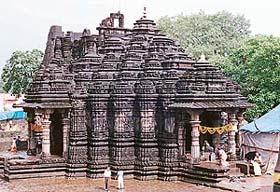 Clouds
gather, rumble, then flash and burst with loud reports...
Streams swell, lakes breach their bounds... It's Tandava:
Shiva's dance. Few of Man's creations can withstand it for long.
Especially in the Konkan,
where the skies pour June through September. But the Shiva
temple at Ambarnath has withstood 943 monsoons
without losing much of its grandeur. Clouds
gather, rumble, then flash and burst with loud reports...
Streams swell, lakes breach their bounds... It's Tandava:
Shiva's dance. Few of Man's creations can withstand it for long.
Especially in the Konkan,
where the skies pour June through September. But the Shiva
temple at Ambarnath has withstood 943 monsoons
without losing much of its grandeur.
Surely,
the temple must be a favourite of its patron god to outlast not
only the rain but also four centuries of Muslim rule and a
forest breathing up its walls!
This
exquisite temple was got built by Chittaraja—a king of the
Silhara dynasty—in the late 11th century. An inscription above
the north-facing door of the temple states Saka 982 (1060 AD) as
the date of construction. The Silharas started out as vassals of
the Rashtrakutas. Govinda III, a Rashtrakuta king, had conferred
the kingdom of North Konkan on Kapardin-I, founder of the
Silhara dynasty, around 800 AD. The Silharas thereafter ruled
North Konkan, comprising the modern Thana, Bombay and Colaba
districts, till 1240 AD. The
temple was constructed at a time when the Silharas were facing
political problems. Chittaraja had to accept the suzerainty of
the Kadambas, another dynasty. Nonetheless, he could muster the
means to erect a beautiful temple.
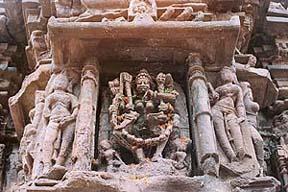

***
The
Ambarnath temple is made of richly carved stone blocks. It is
not very big, like some of the temples down south, but impresses
no less.
The
temple's sides are irregular and one view is that, its floor
plan is based on a spread-out tiger skin-Shiva's mat. It has two
main sections: A mandap or forecourt and the garbhagriha or
sanctum. The mandap has a circular, step-cut roof. It has three
doors, in the north, south and west. The main door is in the
west and it has an idol of Nandi, Shiva's mount, under the
porch. The north and south doors are in a line. The
mandap's concave ceiling has an ornate pattern carved into it.
Its four supporting pillars are also carved top to bottom. Seen
from the west, the mandap's three porches form a 'T'.
The
garbha or sanctum is an uneven circle from the outside. Its roof
was shaped as a spire, but it has partly collapsed. To enter the
sanctum, one has to go up two steps and down twelve from the
mandap. The prayer chamber is lit from a vent at the top. Its
marble flooring, shivling and a Shiva bust modelled on Shivaji
are unmistakably new. Its dark walls are also completely
unadorned. The carvings on the temple's outer walls are probably
theme-based but even a novice can make out carvings of Shiva,
Ganesha and Nandi. Though some of the carvings have been dulled
by seeping water, most stand out sharply. An
Archaeological Survey of India board at the site states that the
Ambarnath temple is "perhaps the
oldest shrine dedicated to Shiva in the coastal parts of
Maharashtra." However, continued worship at the
temple is affecting its beauty. Devotees still burn incense in
the alcoves and pour milk over the Nandi idol. Some restraint on
their part might allow their great grandchildren also to see the
temple in its full glory.
(source: The
timeless temple of Ambarnath - By Abhilash
Gaur
- tribuneindia.com).
For
more refer to chapter on Greater
India: Suvarnabhumi and
Sacred
Angkor
Top
of Page
Symbol
of an awakened civilization
The real India is waking up to a new, historical reality. This awakening
is a result of the unfolding of a mighty creative genius of
millions of unknown Indians whose names are not known and whose
lives are nothing special to remember otherwise. It is they who
can metaphorically be descried as the 'Real Bharat.' They are
charting a new course for the future of our country. The
historic Ram Janambhoomi movement is but a symbol of that new
awakening -- a symbol that reminds the world that India, at
last, is becoming alive to its history.
It
is not just a movement for a temple. It manifests the innate
yearning of a people for self-respect and honour, an urge to
unshackle themselves from the humiliations history heaped
on it. It happens to every country; in fact it has happened
several times in the history of several countries.
About
India this was what Arnold Toynbee
had to say:
'Aurangzeb's purpose in building those three mosques
(Ayodhya, Kashi and Mathura) was the same intentionally
offensive political purpose that moved the Russians to build
their Orthodox cathedral in the city centre at Warsaw. Those
mosques were intended to signify that an Islamic government was
reigning supreme, even over Hinduism's holiest of holy places. I
must say that Aurangzeb had a veritable genius for picking out
provocative sites. Aurangzeb and Philip II of Spain are a pair.
They are incarnations of the gloomily fanatical vein in the
Christian-Muslim-Jewish family of religions. Aurangzeb -- poor
wretched misguided bad man -- spent a lifetime of hard labour in
raising massive monuments to his own discredit. Perhaps the
Poles were really kinder in destroying the Russians'
self-discrediting monument in Warsaw than you have been in
sparing Aurangzeb's mosques.'
(source: One World and India
- By Arnold Toynbee (1960 p
59-60).

Symbol
of an awakened civilization.
***
Medieval
Indian history is replete with instances of wanton aggression on
its holy places by Muslim hordes. Innumerable instances of
defaced Hindu idols and destroyed Hindu/Jain/Buddhist holy
places stare at us everywhere. These destructions were not done
just for the sake of fun as some eminent Indian (read
Marxist) historians would want us to believe. These were
deliberate acts of religious vandalism perpetrated by intolerant
Islamic invaders.
The movement for the Ram Janambhoomi is basically a movement for
the self-assertion of a civilization.
It
is a wounded civilisation trying to re-invent its roots. It has
to be understood properly, instead of dismissed with contempt.
That is what Sir Vidia Naipaul
also says:
'If people just acknowledged history, certain deep
emotions of shame and defeat would not be driven underground and
would not find this rather nasty and violent expression. As
people become more secure in India, as a middle and lower middle
class begins to grow, they will feel this emotion more and more.
And it is in these people that deep things are stirred by what
was, clearly, a very bad defeat. The guides who take people
around the temples of Belur and Halebid are talking about this
all the time. I do not think they were talking about it like
that when I was there last, which is about 20 something years
ago. So new people come up and they begin to look at their world
and from being great acceptors, they have become questioners.
And I think we should simply try to understand this passion. It
is not an ignoble passion at all. It is men trying to understand
themselves. Do not dismiss them. Treat them seriously.' ('The
truth governs writing,' an interview by Sadanand Menon, The
Hindu, July 5, 1998).
(source:
Symbol
of an awakened civilization - By Ram Madhev
- rediff.com). For more
on Sir Naipaul, refer to chapters Islamic
Onslaught and Quotes251_270).
For
more refer to chapter on Greater
India: Suvarnabhumi and
Sacred
Angkor
Top
of Page
Christian
Children's Clubs Bless Communities in India
With more than 1 billion people, India has the second largest
population in the world. More than a third of that population is
made up of children under the age of 18.
 The
predominant Hindu religion offers children little hope for a
better life. But, India's Christians offer hope and a
new life in Christ. The
predominant Hindu religion offers children little hope for a
better life. But, India's Christians offer hope and a
new life in Christ.
India has 380 million children under the age of 18. They are one of
the largest unreached
people groups in the world. Yet, these children are among the most responsive to the Gospel
message. John
DeVries heads Mission
India of Grand Rapids, Michigan. It is a U.S.-based ministry that supports children's Bible clubs
in India.
Each
year tens of thousands of indigenous Indian Christians hold the
clubs for 10 days at a time, in cities across the nation. So,
millions of children learn about Jesus Christ through songs,
games, and instructional materials.
Specifically, DeVries said, "The impact and the answers to
the prayers of children were just sweeping through that area.
And, as our people visited the slum and then walked out of it,
local leaders joined them and said to the leaders of our team, 'You
know, before we walked in darkness but now we walk in light.'
And these were Hindus talking to our team."
(source:
Christian
Children's Clubs Bless Communities in India - cbnnews.com).
Note: If Hindu kids are walking in darkness. then refer to Mass.
Reports 1,000 Church Child Abuse Victims and
Paedophile
cases haunts the Church).
For more refer to chapter on Conversion).
Refer
to VINDICATED BY TIME: The Niyogi Committee Report On
Christian Missionary Activities -
Christianity
Missionary Activities Enquiry Committee 1956
and
The
Sunshine of Secularism.
Top
of Page
Hallmark to
Add Hindu Deepavali Card
 September
17, 2003: This year, for the first time ever, Hallmark will sell
cards for the Hindu celebration of Deepavali or Diwali, as well
as for the Muslim holiday of Eid ul-Fitr. "With the
increase in the number of Hindus and Muslims, we realized there
was an ongoing need that we were not satisfying," said
Deidre Parkes, spokeswoman for the Kansas City, Mo.-based
Hallmark company that has been making greeting cards for
Americans since 1910. While based on a desire to sell more
cards, the new Hallmark cards are also a recognition of the
changing face of America, said Egon Mayer, a sociologist at the
Graduate Center of the City University of New York. Mayer
directed the American Religious Identification Survey, which
showed that the number of Hindu adults in the United States rose
from 227,000 to 760,000 between 1990 and 2001. During the same
period, the number of Muslim adults went from about 527,000 to
1.1 million. September
17, 2003: This year, for the first time ever, Hallmark will sell
cards for the Hindu celebration of Deepavali or Diwali, as well
as for the Muslim holiday of Eid ul-Fitr. "With the
increase in the number of Hindus and Muslims, we realized there
was an ongoing need that we were not satisfying," said
Deidre Parkes, spokeswoman for the Kansas City, Mo.-based
Hallmark company that has been making greeting cards for
Americans since 1910. While based on a desire to sell more
cards, the new Hallmark cards are also a recognition of the
changing face of America, said Egon Mayer, a sociologist at the
Graduate Center of the City University of New York. Mayer
directed the American Religious Identification Survey, which
showed that the number of Hindu adults in the United States rose
from 227,000 to 760,000 between 1990 and 2001. During the same
period, the number of Muslim adults went from about 527,000 to
1.1 million.
(source: Hallmark
to Add Hindu Deepavali Card - For
more visit Hallmark
Press Room).
Diwali
comes to the White House
More
than a hundred Indian community leaders will join US President
George W Bush in celebrating Diwali, the festival of lights, for
the first time in the White House. Giving in to a longstanding
demand of the Indian community in the US, which pointed out that
the White House celebrates festivals of all other religions, but
not Diwali, Bush has agreed to the festivities, which would be
held at the Indian Treaty Room. A
hundred Indian community leaders from different parts of the
United States would attend the celebration organized by Abel
Guerra, Public Liaison Officer at the White House. However, the
event is closed to the press, even to those with regular White
House press credentials, but the attendees are free to publicize
the event afterwards, White House sources said.
(source:
Diwali
comes to the White House - hindustantimes.com).
Englishmen
vandalise Diwali fete in London
The
London Metropolitan police charged the two whitemen who
gate-crashed into a Diwali
celebration at the Sanathan Mandir
in Ealing Road and desecrated
the idol of Lord Rama with "religiously aggravated criminal
damage".
The
two men, identified as Toby Champeney, 40, part-time worker with
no fixed abode and Benjamin Lloyd, 27, an occupational therapist
from Uxbridge, were to be produced before Brent Magistrate, a
spokesman of the police told PTI. The
two Britons, who broke the idol of Lord Rama at the Ealing Road
Sanatam Mandir in Wembley last month, were sentenced for
"racially aggravated criminal damages". The Brent
Magistrate Court on November 17 sentenced Toby Champney to two
months imprisonment for "racially aggravated criminal
damages". His fellow Christian
preacher, Benjamin Lloyd Jones was fined 400 pounds for racially
aggravated threatening behaviour, and set free. The
lower court's sentence has angered the Hindu community and many
of them have raised the question of why a higher court had not
heard the case.
(source:
Englishmen
vandalise Diwali fete in London - sify.com
and Two
Britons sentenced for breaking Ram idol - hindu.com).
Top
of Page
India
needs common civil code: President
A P J Abdul Kalam
Chandigarh:
Responding to a query on the need for a uniform civil code at an
interactive session with 900 school students at the PGI on
Monday, President A P J Abdul Kalam made it clear that a
uniform civil code was required keeping in view the population
of the country.
He said, ''We
are a billion-strong population and any law has to be uniformly
applicable.'' In the midst of the his favourite audience, Kalam
came across as a charmer deftly tackling the queries thrown at
him by the students. Questions also touched on national security
issues, brain drain, the reservation policy, the utility of
India's nuclear programme, vote bank politics and the country's
space programme.
(source: India
needs common civil code: Kalam - timesofindia.com).
Top
of Page
BJP
to launch stir for Dalits’ temple entry
The
BJP will conduct a survey of such temples and other religious
places in the state where Dalits are denied entry for offering
prayers or prasad. And after identifying such temples and other
religious places, an agitation will be
launched for Dalits’ entry into them.
An
announcement to this effect was made by leader of the opposition
in the state assembly Sushil Kumar Modi on Sunday at Bahera
village of Kaimur district, where a Dalit was shot dead when he
tried to offer prayers and prasad to the goddess during the
Durga Puja on October 4, defying the long-standing ban imposed
by upper castes.
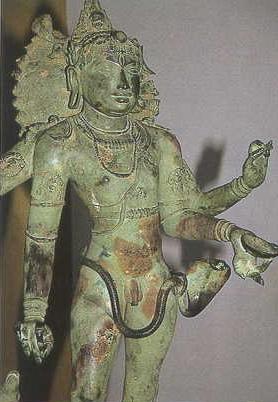 Modi promised that without caring
for the political implications of his decision, he would himself
lead the agitation for Dalits’ entry into the religious
places. He called upon all the political parties to join the
fight against such social evils. Modi promised that without caring
for the political implications of his decision, he would himself
lead the agitation for Dalits’ entry into the religious
places. He called upon all the political parties to join the
fight against such social evils.
(source: BJP
to launch stir for Dalits’ temple entry - timesofindia.com).
Top
of Page
A
one man army out to propagate Hinduism
He
is an academic, a Hindu missionary, a master of Hindu philosophy
and religion, an Indian in love with Indonesia, all rolled into
one. Dr. Somvir, a member of the faculty of letters at the
Udayana University here and a resident of this Indonesian
resort, says his mission in life is to spread Hindu values, come
what may.
. "I am here to propagate Hindu religion and
philosophy," Somvir. "I have no other love, no other
interest. I am engaged in this effort every single minute, and I
like it immensely." In
Bali, where 95 per cent of the three million people practice a
form of Hinduism that is blended with Buddhism.
He
has just been given two hectares of land to start a gurukul,
a boarding school modelled on Hindu lines, to cater to some 400
students. The gurukul that will come up in 2004
will teach modern subjects as well as Sanskrit, English and
local languages.It will also serve as a home to 10 cows, an
animal revered by Hindus. Somvir, a Yadav who stopped using his
family name decades ago, first came to Indonesia in 1993 to do
research on the origins of Sanskrit sources in Ramayana in
Indonesia and spent a year researching in Jakarta and Bali. "Since
coming here I have done nothing except propagate Hinduism and
Hindu philosophy," he says. "I decided this is what I
will do, whether or not I get any assistance. I have so far
taught more than 3,000 students."
The Indian Council for Cultural Relations finally recognized his
efforts and has been funding his work since 1999. He now teaches
Sanskrit, Vedas and Hindu ethics in three universities here, for
free. Somvir
has opened a yoga centre named after saint-philosopher Swami
Vivekananda at Bali's Maha Saraswati University, where a weekly
class is held free every Sunday and is attended by some 40
people.
"There
is tremendous interest in Hinduism and in particular Ramayana
here," he said. "Ramayana is like a daily diet of the
people. Both Sanskrit and Ramayana are embedded in people's
minds. "There
is hardly anyone here who does not know the Ramayana or does not
sing its verses." Somvir is now putting together a
dictionary of 2,000 words from Bhasa Indonesia and the old
Javanese language that owe their origin to Sanskrit.
(source:
A
one man army out to propagate Hinduism
-
hindustantimes.com).
Top
of Page
Don’t
follow the West blindly: says Governor
M Rama Jois
Governor
M Rama Jois has
noted: "He also laid stress
on the position of women in our culture. He said a mother stands
next only to God. He said that beauty shows are
harming the Indian culture. "Ugly exhibition of beauty for
money is wrong," he opined. The governor said that
education minus "dharma" and culture would create
brutes and that "literate necessarily doesn't mean educated
people."
Quoting
from Fatherless
America he said that 65
per cent American children do not know who is their father.
"If we follow western tradition, we will also meet a
similar fate," he cautioned and advised the children never
to alienate themselves from their tradition. "
(source:
Don’t
follow the West blindly - timesofindia.com).
For more on M Rama Jois refer to chapter on Quotes321-340
Top
of Page
 Did
You Know? Did
You Know?
Spirited Away
– Asia’s Looted Treasures
In India,
Cambodia and China, ruthless art thieves are stripping cultural
sites of precious artifacts, then shifting them to smugglers and
dealers who hawk them overseas.
No country has lost so much so
quickly as Cambodia, whose jungles hid cities built by the
mysterious Angkor empire between the 9th and 14th centuries.
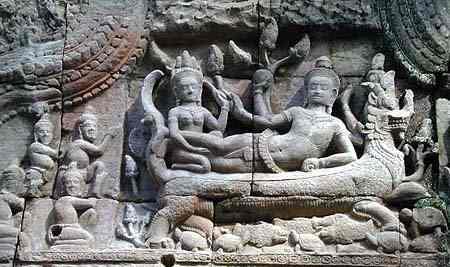
Vishnu and
Lakshmi
***
Peace has proved far more
destructive to the turbulent nation's antiquities than war. When
the relic-rich northwest was under Khmer Rouge control through
the mid-'90s, Western dealers couldn't reach many of the prime
sites for fear of land mines or crossfire. It was only with the
full cessation of civil war a few years ago that foreigners
could once again freely visit the relic sites around the
legendary Angkor Wat temple complex. Since then, thousands of
ancient Khmer relics have flooded the art market.
Most of the antiquities travel
overland from Cambodia to Thailand, where ritzy Bangkok
galleries openly display looted relics. "Of course they are
all real," says a saleswoman in one of the galleries, gesturing
toward two 1.5-meter-high statues of the Hindu god Vishnu in the
window priced at $17,500 each. "I'll give you a
certificate that says so." She has more in the back—even
though other Bangkok shopkeepers say such items are getting
harder to come by. A ban on the import of Khmer stone
antiquities by several industrialized nations, including Japan
and the U.S., coupled with regular Thai police raids on antique
shops have curtailed the trade. But the saleswoman remains
undaunted. "You can have these for a bargain," she
says.
In the
meantime, the industrial-scale looting continues unabated. In
1999, entire slabs of bas-relief from Banteay Chhmar, a
magnificent temple in western Cambodia, were loaded onto trucks
and driven to Thailand. Roads were bulldozed through the jungle
to carry out the sandstone chunks, leading Thai police who later
intercepted the load to charge the Cambodian military with
complicity. This March, looters trekked upriver to Kbal Spean, a
distant jungle enclave where elaborately carved bas-reliefs from
the 11th century decorate the riverbed and surrounding rocks. It
was nighttime, and they found the site unguarded due to lack of
funds. Using an electric saw, the
raiders gouged out the face of Vishnu and his wife Lakshmi.
Apparently, they were not experts: Lakshmi's face cleaved into
several pieces, one of which was found beside the desecrated
site the next day. Still, Tranet estimates that the Vishnu face
alone could sell for up to $50,000 in Bangkok—and several
times that in the West.
(source: Spirited
Away – Asia’s Looted Treasures - time.com).
For
more refer to chapter on Greater
India: Suvarnabhumi and
Sacred
Angkor
Top
of Page
|